
How to Create a Resume in Microsoft Word (Step-by-Step Guide)
If this is your first time creating a resume in Microsoft Word, the process may seem overwhelming. Luckily, this article is here to help! In this step-by-step guide, we will cover how to create an effective resume from start to finish using Microsoft Word.
How Do I Make a Resume in Microsoft Word?
There are two primary methods for making a resume in Microsoft Word:
- From Scratch: This gives you the ultimate creative control. However, it also requires you to familiarize yourself with all of Microsoft Word’s tools and layout options. Building a resume from scratch can be more time-consuming but also more customizable.
- From a Template: Microsoft Word offers several pre-made resume templates. By using these, all the formatting and layout creation is handled for you. You simply have to fill in your own information.
To use a template, go to File > New and then select a template from the Resume and Cover Letter section.
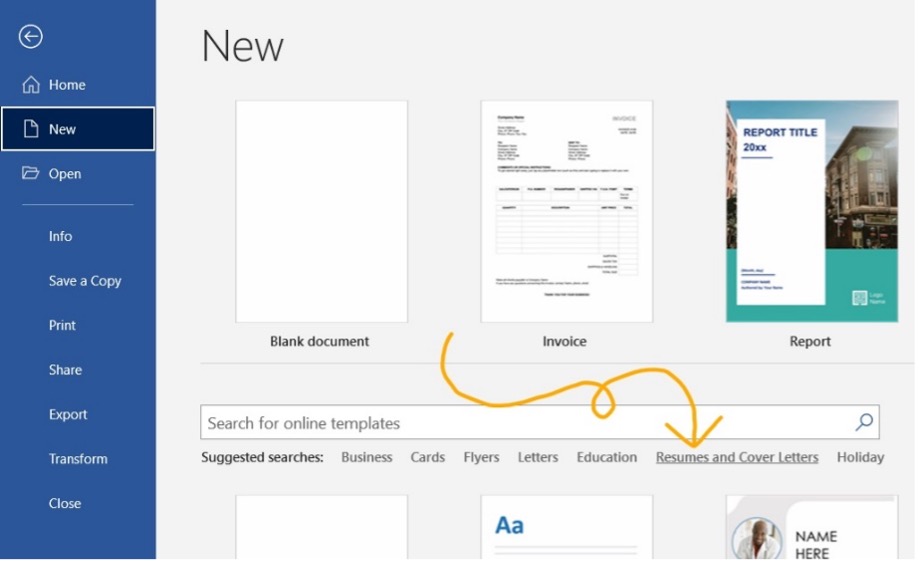
How Should I Format My Resume in Microsoft Word?
The format you choose will depend on your experience level!
There are 3 basic resume formats to choose between:
- Reverse-Chronological: Details your most recent job and works backwards from there. This format focuses heavily on work experience.
- Functional: Focuses on skills and education rather than work experience. This is a good option for recent graduates or applicants with minimal work experience.
- Hybrid/Combination: Combines elements of both the Reverse-Chronological and the Functional. This is a good option for applicants with gaps in their employment history.
Choosing the best format for your needs is key. For more help on this subject, check out our guide on How to Choose the Correct Resume Format in 2024 !
Beautiful resume templates to land your dream job

Make a Resume in Microsoft Word in 7 Easy Steps
First, let’s make sure you can navigate the Microsoft Word ribbon!
The ribbon is the toolbar found at the top of the screen.
It should look something like this:

The main parts of the ribbon you should familiarize yourself with on the Home tab are Font , Paragraph , and Styles .
These are how you will edit the appearance of your text and headers.
You should also familiarize yourself with the Layout tab .
This tab is where you will adjust your margins and add columns!
Once you have taken your time to figure out where all of your tools are, it’s time to begin building your resume!
Important Note: These steps detail how to create a resume in Microsoft Word from scratch. By using one of the program’s pre-made templates, you can bypass many of these steps and simply fill in the pre-made format.
Step 1: Create Your Layout
Let’s begin by visiting the Layout tab .
Here, you can set your margin size and decide if you want to use columns.
Here is a breakdown of these two elements:
We recommend using 1-inch margins on all sides.
This will give you enough white space to keep your resume looking neat without sacrificing too much space.
It will also ensure your formatting looks good on printed versions of your resume.
Columns and Sidebars:
From the columns tab, you will find five options:

- The One , Two , and Three options are how you will create separate columns.
- The Left and Right options are how you will create sidebars! Sidebars are useful because they leave more room for the main text and sections.
From the Home tab , you can edit the following elements of your layout:
Alignment:
Choose between left, center, or right alignment.
We recommend using the left alignment.
Whichever you choose, it is a good idea to keep your alignment consistent across the board.
Line Spacing:
We recommend using 1.15 – 1.5 line spacing for the body text.
For section titles and headers, use 1.5 – 2.0 spacing to help them stand out from the rest of the text.
Use a simple and highly legible font. Try to use only 1-2 fonts throughout your resume.
We recommend the following seven fonts:
- Times New Roman
Step 2: Make Your Title Header
Your title header should contain the following information:
- Your Job Title
- Contact Information
- Professional Social Media Links
Use an H1 header to write your name at the very top.
Use the Normal style to write the rest of your information (see “How Do I Add Different Sections of the Resume on Microsoft Word” below for more information on header styles).
It should come out looking similar to this:
Copywriter Email: [email protected] Phone: (123) 456-7890 Website: Janesmith.com LinkedIn: linkedin.com/in/janesmith
Check out some of our free resume examples to see alternative ways of formatting your title header!
Step 3: Write an Objective or Summary
Following your title header will be your resume objective or summary.
This will be a short statement between 1-5 sentences detailing your desired job title, experience, and career goals.
You will want to write this statement in the Normal style .
However, you may want to use a slightly larger font than the rest of the text in other sections.
This will help your objective or summary statement to stand out.
Here is an example of how this might look with the title header example from before:
Resume Objective: I am a copywriter with over 5 years of experience. working with corporate clients. I am seeking the position of Head Copywriter at your company, bringing with me over 10 major corporate clients.
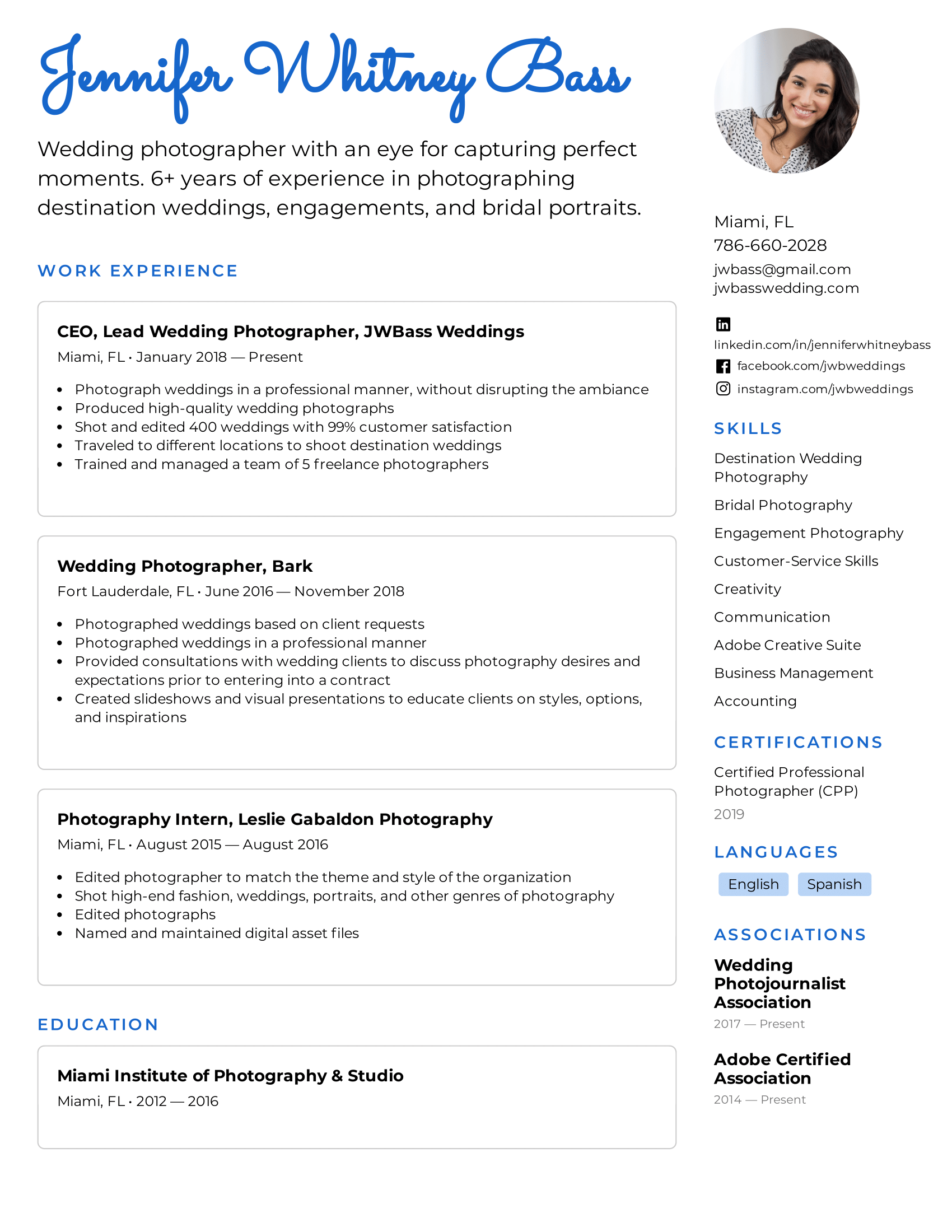
Step 4: Create Your Base Format
By creating a base format, you can save the document as a separate file to return to and fill in again and again.
This will help you to tailor your resume to fit specific jobs!
The idea of the base format is to provide outlined sections with the correct spacing and number of bullet points.
You are essentially creating a skeleton for your resume that you can edit and adjust over time.
By doing so, you ensure you have already allocated the proper amount of space on the resume for each section.
For example, this is what your base Work Experience section may look like:
Work Experience
Job Title 1 , Company Name Date – Date · Descriptive Sentence · Descriptive Sentence · Descriptive Sentence Job Title 2 , Company Name Date – Date · Descriptive Sentence · Descriptive Sentence · Descriptive Sentence Job Title 3 , Company Name Date – Date · Descriptive Sentence · Descriptive Sentence · Descriptive Sentence
As you gain more work experience, you can return to this base format and make changes as need be.
Because you have already outlined the section, you won’t have to worry about reformatting the entire resume to make a few simple changes.
Step 5: Determine Your Section Organization
Once you have built the base format of your resume, it’s time to determine if your sections are in the optimal location.
For instance, if you are creating a Reverse-Chronological style resume you will want your Work Experience section to come first.
Comparatively, if you are creating a Functional style resume you may want your Skills or Education section to come first.
The order and organization of your sections will impact the impression your resume makes on hiring managers.
Step 6: Fill in the Information
Now that you have created the base format of your resume and chosen the optimal organization, it’s time to fill in your information!
When filling in your information, be mindful of the following 3 factors:
- Be Concise: Always use simple sentences that clearly describe your strengths and accomplishments. Avoid complex sentences or overly complicated vocabulary and jargon.
- Use Bullet-Points: In each section, use bullet points to separate each thought or idea. This will make your resume more visually appealing and easier to read.
- Choose Compelling Language: Try to avoid repeating the same words or phrases over and over. Mix it up, use keywords, and find the best action verbs to make your resume sound even better!
Not sure how to make your language more compelling on your resume? Take a look at our list of 350+ Action Verbs to Make Your Resume More Effective in 2024 .
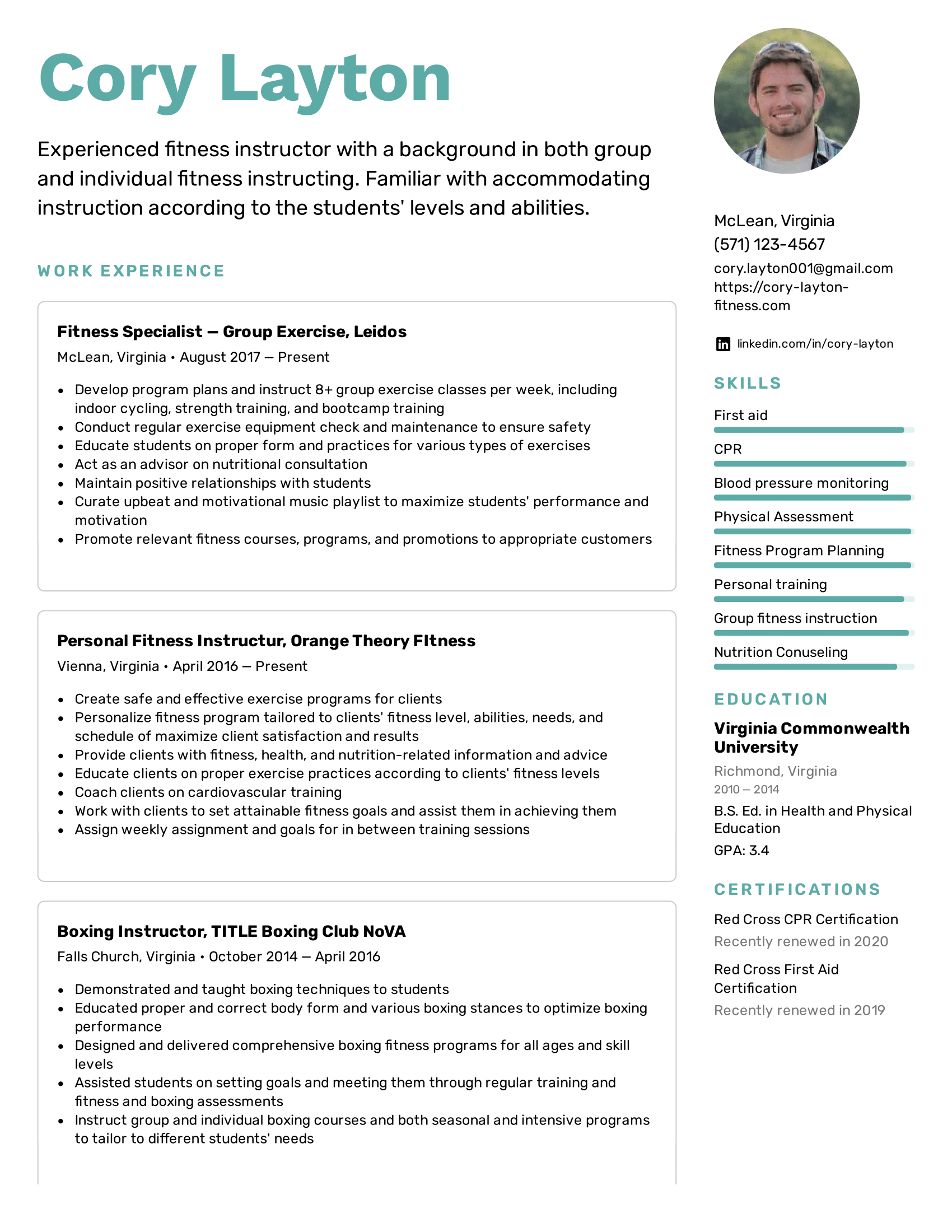
Step 7: Double-Check Your Sections
Once you have completed steps 1-6, look back over your resume and make sure you have included all of the key sections.
You should also take some time to consider what additional sections you could include.
Here are the key sections every resume should have:
- A title header with your name and contact information
- An objective or summary statement
- Work experience
As we have covered, the order of these sections will vary depending on the format you have chosen.
However, each of these sections should always be included in your resume.
There are also some additional sections to consider adding.
Here is a quick list of extra sections that can add some extra flair to your resume:
- Awards and achievements
- Certifications
- Unpaid experiences, such as volunteer work or internships
- Relevant hobbies
How Do I Add Different Sections to a Resume on Microsoft Word?
The way to create different sections on your resume comes in two parts:
- Use an H2 header to create the section titles (Work Experience, Education, Skills, etc.)
- Use the Normal style to create the body of text below the H2 header
Here is a breakdown of how to use the H1, H2, H3, and Normal styles within your resume:
Select the Styles window from the Home tab .
From here, you will have options to create headers.
Your heading options are as follows:
- Heading 1: Use this heading as your largest title. This is what you will use to write your name at the top of the page. Use a bolded font between 16 to 20 pt in size. Use 1.5 to 2.0 line spacing to help the title heading stand out.
- Heading 2: Use this heading to create your section titles. Use a bolded font size between 14 to 16 pt. in size. Make sure these headings are smaller than your title heading. Use 1.5 to 2.0 line spacing to help these headings stand out from the rest of the text.
- Heading 3: Use this heading to create your job titles. Your job titles should be only slightly bigger than the rest of the text. Use a bolded font between 12 to 14 pt. in size. Use between 1.15 to 1.5 line spacing.
- Normal: Use the Normal style to create the body text underneath the heading. Use a regular font between 11 – 12 pt. in size. Use between 1.15 to 1.5 line spacing.

What are the Pros and Cons of Using Microsoft Word to Craft Your Resume?
Microsoft Word is a handy tool to have, especially if your computer comes with the program pre-installed.
Here are 3 pros and 3 cons to using Microsoft Word to create your resume:
- Total Creative Control: When creating a resume on Microsoft Word directly from your computer, you have total control over the design and format.
- More ATS Friendly: Applicant Tracking Systems are designed to read .doc files, the file format used by Microsoft Word.
- Can be Edited by Recruiters: If you are using a recruitment agency, a Microsoft Word file can be easy to edit by recruiters before sending it off to employers.
- The Microsoft Word Learning Curve: If you are unfamiliar with Microsoft Word, there can be a pretty steep learning curve that can cause you frustration.
- Time Consuming: Building a resume from scratch can be highly beneficial, but also highly time-consuming. This can become problematic if you need to create a resume quickly.
- Temperamental Templates: Microsoft Word offers tons of free resume templates. On the surface, this is super useful. However, these templates can be tricky to use. One wrong move can mess up the formatting in a big way and be an even bigger headache to try and fix.
Why Should I Use an Online Resume Template or Resume Builder?
By using a resume template from an online provider, such as Easy Resume, you are more likely to find a template that fits your exact needs.
Plus, online resume templates and resume builders often have more design elements that are easier to use compared to Microsoft Word.
Are you interested in using our online templates or resume builder? Check out our beautifully designed resume templates to build your optimal resume!
Final Takeaways
Microsoft Word offers a lot of capabilities to help you build your ideal resume.
Here are five key takeaways for creating a resume on the program:
- Create a base skeleton for your resume that you can use again and again for different jobs.
- Use different heading styles to help your resume title and section titles to stand out.
- Use the column tool under the Layout tab to create sidebars. Sidebars are great for smaller sections, such as certifications or awards!
- Always use concise and compelling language.
- Consider using a template to build your resume faster.
At Easy Resume, we have designed our resume templates and online resume builder to fit your needs. No matter your level of experience or skill at making resumes, we have the tools to help.
Don’t forget to check out our expansive collection of FREE resume guides and examples while you’re here!
Browse more resume templates that fit your role

Ed is a co-founder of Easy Resume. His background in scaling teams at tech startups over the last decade has given him extensive experience and knowledge around how to hire top talent and build successful teams. He enjoys mentoring, coaching, and helping others reach their career goals. When he's not writing about career-related advice, he's playing with his dog, Lilo, or going on long hikes in upstate New York.
Get inspired with more resume examples
More advice that will accelerate your career path, 15+ key healthcare skills to list on your resume in 2024 (with examples).
Healthcare is a massive and important industry that contains all sorts of professionals. To land a job in healthcare, you must understand what relevant skills employers are searching for. In this guide, we will cover key healthcare skills to include on your resume and why doing so is so important.
15+ IT Skills to List on Your Resume in 2024 (With Examples)
IT is a massively growing industry with tons of potential for professional growth. It’s no wonder why so many applicants are flocking to these jobs! In this guide, we will cover what IT skills are and offer you examples of some of the top skills to include on your resume.
50+ Key Technical Skills to List on Your Resume in 2024 (With Examples)
Including technical skills on a resume is an absolute necessity. These types of skills show employers your quantifiable qualifications. In this guide, we will cover exactly what a technical skill is and some of the best examples to include on a resume.
20+ Key Computer Skills to List on Your Resume in 2024 (With Examples)
With the world becoming more digitally focused, having strong computer skills is more important than ever. In this guide, we will cover what computer skills are and which ones are best to include on your resume.
Read our how-to guides on making your resume perfect
How to write a resume header.
Your resume header is the very first thing an employer will see. Not only does it need to contain the correct information, but it needs to stand out as well! In this guide, we will teach you how to write the ideal header for your resume.
How to Write Your Resume in Reverse-Chronological Order
When setting out to write the perfect resume, choosing a format is an important decision. Reverse-chronological resumes are the standard format, so knowing how to craft one is key! This guide will teach you how to write the best reverse chronological resumes.
How to List Contact Information on Your Resume in 2024
Learn how to format contact information on your resume and what information to share with the hiring manager.
How to Write a Two-Page Resume (with Examples & Tips)
Don't know whether you should write a one-page or two-page resume? Find out when it is appropriate to write a two-page resume and learn how to write it correctly.
Professional resume templates to help land your next dream job.

Facebook • Twitter • Linkedin • Pinterest • Crunchbase
Resume templates
Put your best qualities on display with professional, customizable resume and cv templates. no matter your line of work or length of professional history, you'll find resume and cv templates that'll help you get the gig..
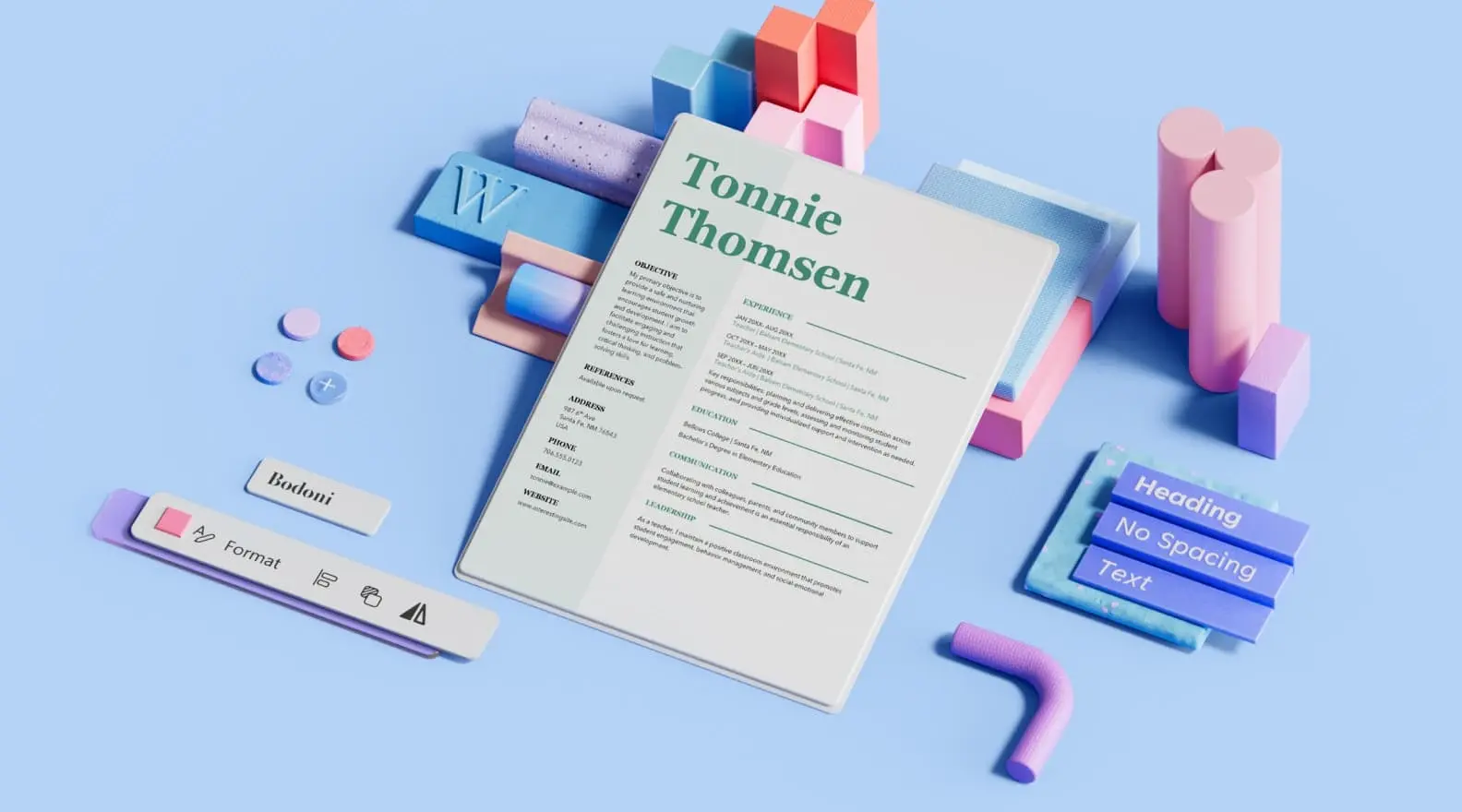
Download free resume templates
Land your dream job with free, customizable resume templates. Showcase your potential to recruiters and stand out from other candidates with a professional template. Whether you're applying to corporate positions or creative roles, go with a sleek design or show your creativity with bold colors .
Resumes don't need to look boring—add flair to your professional experience with a creative resume template. There are plenty of resume designs to choose from, like simple resume templates and modern resume templates. Each resume template is fully customizable in Microsoft Word , so you can personalize each design element and add your own text. Using a template also makes it easier to customize your resume for each position you apply to.
Print out as many copies as you'd like or download the template for free to share digitally when applying online. These professional resume templates are perfect for any stage of life or career. Whether you're a high school student, actor, or seeking a career in nursing, you can find any format for any job type.
There are also a variety of free CV (Curriculum Vitae) templates to choose from. A CV is often longer than a resume and contains an in-depth look at your education and professional accomplishments. Like our resume templates, these CV templates are also customizable in Word.
Remember, your next job is only a template away! Once you've customized your resume, explore free cover letter templates to help you land the job.
How-To Geek
How to create a professional résumé in microsoft word.

Your changes have been saved
Email is sent
Email has already been sent
Please verify your email address.
You’ve reached your account maximum for followed topics.
The Best Turntables of 2024
My 6 favorite uses for samsung dex, these formerly paywalled ai tools are now available for free users, quick links, what is a résumé, using a microsoft word résumé template, crafting a custom résumé in microsoft word, deciding what information to include, organizing that information.
Pressing the send button when sending your résumé to a potential employer can be a nerve-racking experience. We're here to show you how to create a résumé using Microsoft Word and provide a few tips on getting you through the résumé screening process so you can press that send button with confidence.
A résumé, often referred to as a CV (curriculum vitae), is a summary of a person's background and experience, including work experience, education, and even volunteer work, and its most common use is to send to potential employers when searching for a new career opportunity. In fact, though taking on a much different form than that of what you'd expect a résumé to look like today, Leonardo Da Vinci even did this himself, and he is often given credit as the first person to create a resume.
Of course, the résumé has undergone quite the transformation since Da Vinci's 1482 version, drastically so during the age of word processors and digital typesetting in the 1970's---40 years after résumés became an institution. Fast-forward to today and not only do you have your standard .doc or .pdf résumé, but you'll also see people uploading video résumés on YouTube and using social media platforms like LinkedIn to sell themselves to companies.
We should be thankful for these developments because now we can skip the quill and ink and jump straight into Microsoft Word.
Microsoft Word offers a bunch of résumé templates. Some are beautiful; some are not. We'll let you decide which style fits you best, but here's where you can find them.
Go ahead and open Word. As soon as you do, you'll be greeted with several different templates to choose from, ranging from a simple blank document, cover letters, résumés, or even seasonal event flyers. Click the "Resumes and Cover Letters" link under the search box to see only those types of templates.

Now, you'll see all the different resume styles Word has to offer. There are a lot of different styles and color schemes to choose one, so pick what feels right. If you scroll down the list a bit, you'll also see some plainer resume templates designed for different purposes---like an entry-level, chronological, or extended CV style.
Some of the templates are already built into Word; others are a quick, free download from Office.com (and you won't even have to leave Word to grab them). When you click to create a resume, Word will let you know the download size (if it needs to download the template). Click the "Create" button and a few seconds later, you'll be in your document and ready to edit.
That's all there is to it! But what if you didn't find a résumé you liked? Luckily, Word has a few formatting tools to help you craft the perfect résumé.
Before we start, it's important to know that each résumé should reflect a person's personal experience and education. Since everyone's experience is different, it's no surprise that their résumés will be too.
That being said, there are some general aesthetic guidelines for making a résumé that we highly recommend you follow for a professional-looking document .
Go ahead and open up a clean, blank document in Word.
The first thing we'll want to do is set our margins. Go to the "Layout" tab and click the "Margins" buttons.

The drop-down menu displays several different margin options from which to choose. If you can't find the one you're looking for, you can click "Custom Margins" at the bottom and enter your specifications. Let's go ahead and do that.
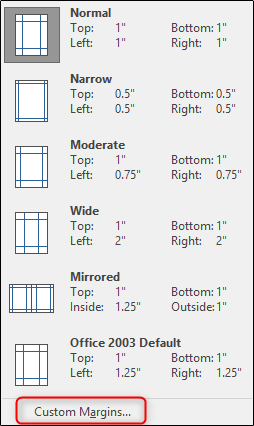
According to the experts, the best margin size is 1" for the top and bottom and 0.63" for the sides. This may seem like an oddly specific number, but the objective is to get as much (relevant) information about yourself as possible on a page without overwhelming the reader. With the above credentials, we leave enough white space on the page for the reader to not feel suffocated.
Click "OK" once you've entered the margin sizes you want.
Now that our margins are set, it's time to start inputting information.
The information you put mainly depends on what you're trying to accomplish and where you are in your professional career. If you have over two years of working experience, then detailing that information is much more valuable than which high school you graduated from or which clubs you were a part of in college. Like a cover letter, your résumé should uniquely cater to the recipient. Dress to impress.
So, which information should you put? We'll give you the overview, and you can decide which areas you should detail.
- Contact Information
- Professional Experience (It's also ok to include any volunteer work at the bottom of this section)
- Additional Skills
For all of these, tailor the information to the job. You don't need to fit irrelevant work experience in there unless not including it would create a gap in your work experience. But if you're applying for a job as an accountant, nobody cares that you delivered pizzas 12 years ago. And you do list out any additional skills, make sure they're relevant to the position for which you're applying. Your high school friend might be impressed by how high you can kick, but your future employer---not so much.
Another thing to remember is that you should always list out your experience in reverse chronological order. That is, list out your most recent experience first, and go back from there.
There're several ways to do this, but arguably the most effective way is by creating headings and then inserting a table for the content of each section. By doing so, you're not only able to move content around in groups instead of individually, which can be a headache in itself, but you're also able to give your résumé a unique touch by adding table designs. In the image below, for example, we've added a dashed border to the left side of the table to create a nice little visual element to tie the different experience elements together.
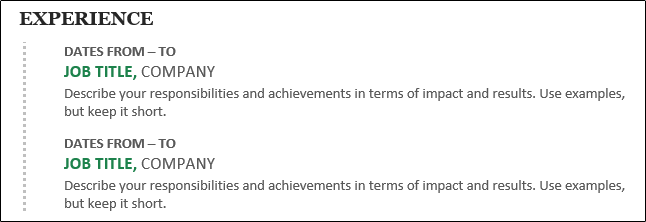
First things first, let's go ahead and find a heading that we like. In the "Styles" section of the "Home" tab, you'll find several default styles. If you can't find one you like, then Word has a feature that lets you create your own. First, click the "More" arrow on the right-hand side of the different built-in styles.
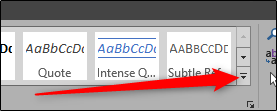
You'll see a menu with three different options. Go ahead and click "Create a Style."

The "Create New Style from Formatting" window will appear. The only thing you can do here is to name the style, so click "Modify."
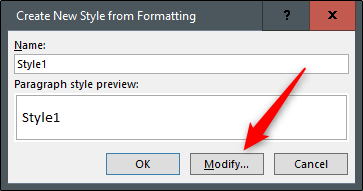
Now you should see a window with many formatting options. For fonts, there's no best option. Just make sure you use something that's clean and readable. "Georgia" is a great example. A 14 pt font size is fine for headings, but make sure it's bold so that each section is easier to find for the reader.
The "Add to the Styles gallery" option will automatically be selected. It's good to leave this option selected so you'll have easy access to your heading for the other sections of your résumé. If you plan to use this heading again in future documents, you can go ahead and deselect "Only in this document," but since we only plan to use it for our résumé, we'll keep that option selected.
Click "OK."
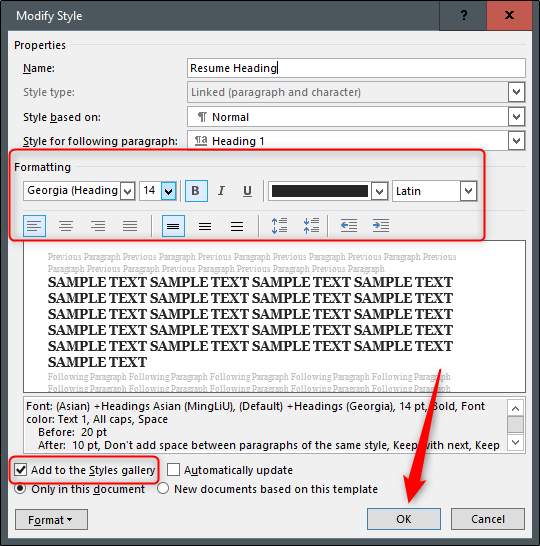
Go ahead and type in your first heading and apply the new style to it. In this example, we'll use "Experience" first.
Now, let's use a table under our first heading so that we can keep all our content lined up correctly. Place your insertion point on the line under your new heading, switch to the "Insert" tab, and click the "Table" button.
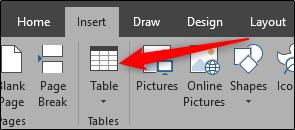
You'll see a 10x8 grid on the drop-down menu. You can create the table size by moving your mouse over the grid and clicking when it's the size you want. For your résumé, you'll need one column and enough rows to contain the separate pieces of information you have to list. For example, if you have three prior jobs to list in the Experience section, you'll want a table that's 1x3.
And here's what it looks like after we've inserted the table into the document.
We'll remove the border lines later. First, go ahead and put in your information. You'll want the "Job Title, Company" text to be 1 or 2 pts larger than the rest of the text but be sure to keep it smaller than the heading of the section. If you want your job title to stand out, you can change the color or make it italic, but try to keep it simple.
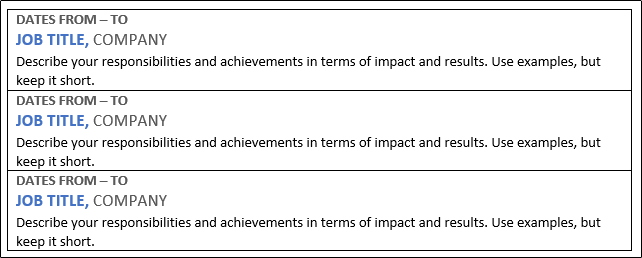
Once that's ready, let's go ahead change the borders of our table. Select the table by placing your insertion point anywhere inside it. Switch to the "Design" tab in the "Table Tools" section of the Ribbon, and then click the "Borders" button.
If you want to keep it simple and remove all the lines of your table, select "No Border." In this example, we're going to give our table a little flavor, so we'll select "Borders and Shading."
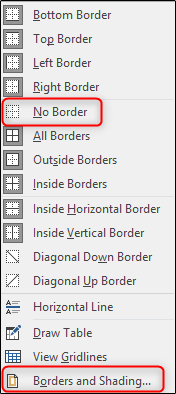
Because we only want to customize the left border of our table, we will select "Custom" under the "Setting" section. This lets us use the "Preview" section to deselect the sides on which we don't want borders. Click the boxes surrounding the preview to turn off all the borders except for the left one.
In the "Style" list, you can select the border design, color, and width you want. Click "OK" when you're ready.
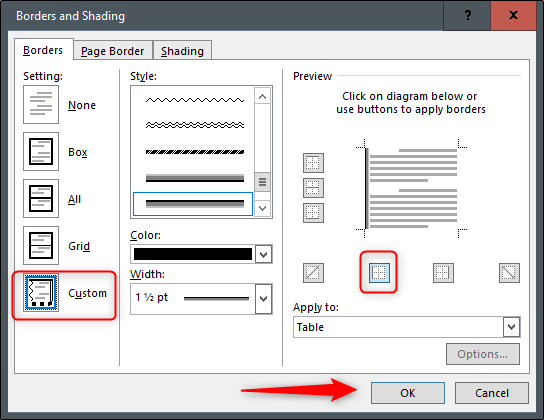
Now we should have an experience section on our résumé that's starting to shape up. A little playing with colors and maybe spacing the table rows a bit, and you should be ready to go.
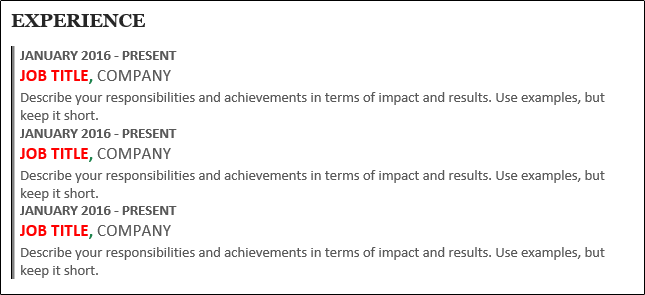
Now, just repeat these steps for the rest of the sections and your professional résumé will be finished in no time!
Image Credit: fizkes /Shutterstock
- Microsoft Office
- Microsoft Word
How to Make a Word Resume in 2024 - 7 Easy Steps

At some point or another - meaning, before online resume builders made our lives easier - most of us have had to make a resume in Word.
Now, making a resume in Word can be tiresome. Not being entirely optimized for the task, it can give you a hard time formatting and styling your resume to your needs - and this is just one of its disadvantages.
That being said, the use of Word is unlikely to drop only because it’s impractical. This means that knowing how to make a resume in Word is still a good skill to have. And if you’re sitting and thinking: “well, this doesn’t make matters any easier” - we hear you.
That’s exactly why this article is here - to teach you how to make a resume in Word, in just a few easy steps.
- Should You Make a Resume in Word?
- How to Make a Resume in Word in 7 Easy Steps
- How to Format your Resume - 3 Pro Formatting Tips
But before we dive into the nitty-gritty details of how to make a resume in Word, let’s go through the downsides of using it to build your resume, and what other easier alternatives you might have in more detail.
Should You Make a Resume in Word?
Microsoft Word might once have been a top resume-building option, but that time is long gone. Although it has ready-made templates, Word in itself was never meant to be a resume builder - this reflects on the end product, which often looks old-fashioned and dull.
Not to mention that it offers very little space for creativity. Try to make a small change in the layout and see the format crumble in front of your eyes.
On the other hand, if you simply use the Word template without customizing it, yours might just become another resume in the crowd that won’t even pass the Applicant Tracking System (ATS) - the software most companies use to filter through countless resumes they receive daily.
Long story short, here are MS Word’s main cons as a resume builder:
Long story short, here are MS Word’s main cons as a resume builder:
- It can be clunky and outdated - chances are, any Word template you choose to use for your resume will look old-fashioned. Technology has changed what is expected of your resume, just as it has changed job-search over the last decade.
- It is not ATS-optimized - the software that most recruiters use not to waste time looking at the resumes? Well, most Word templates are not optimized for it. This means that you can be the fittest candidate for the job and not even get invited to an interview.
- It’s time-consuming - making changes to the layout of a Word resume template is a nightmare.
Everyone knows what happens when you move an image in Word:
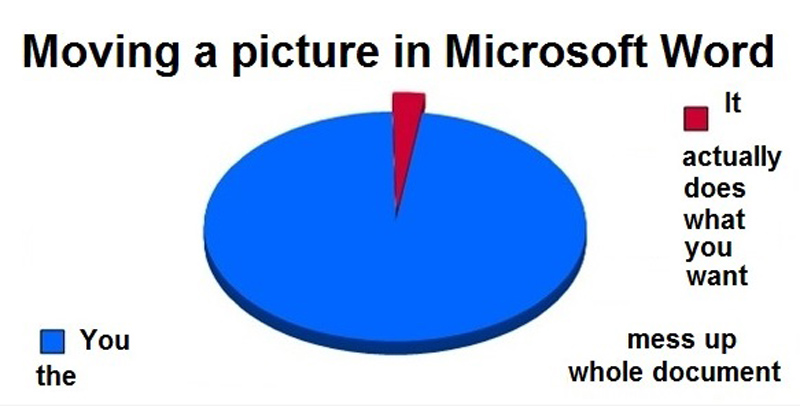
It’s exactly for these reasons, as well as the added efficiency, originality, and time preservation, that online resume builders are the obvious choice for creating your resume.
Novorésumé’s online resume builder is fast, easy to use, and perfect if you want to land that interview. You can start building your resume immediately just by clicking on the link, or you can pick one of our free resume templates , according to your needs.
Step #1: Pick a Word Resume Template
The first step in making a resume in Word is accessing its free resume templates. How you access the templates may change depending on the Microsoft Word version you’re using, but what you ultimately need to do is the following:
Open Word.
Select one of the Resume templates Word suggests, or simply search for “resume” and you’ll find a bunch more.
Choose the resume template that best fits your qualifications and professional profile.
Click “Create.”
You’re good to go: the template should appear as a Word document ready to be filled with your personal information and all other relevant sections.
Step #2: Create a Resume Header
From this point on, things should be pretty easy to pick up.
Start filling up your resume from the top, which is where the resume header is located. Traditionally, the header should include the following information:
- First and last name
- Phone Number
- Location (Street Address, City, State)
You may notice the lack of optional information in this resume template, such as your professional job title , your LinkedIn URL , or social media links.
If you feel like that info will significantly improve your resume, look for a Word template that includes them, or manually add them to the template you’ve already chosen. We’ll go over some formatting techniques to improve your resume template later on in the article.
Step #3. Include a Resume Summary or Objective
Next, you need to describe your professional experience or professional goals (in case you lack the experience) through the resume summary or objective.
Write a resume summary or resume objective - depending on which one best fits your resume - and try to express yourself in a way that will keep the recruiter’s attention for more than the traditional 7 seconds .
Quick recap: a resume summary is a 2-3 sentence overview of your career and is used in 90% of the cases. A resume objective is more commonly used among those with little professional experience or those who are changing careers and describes your professional goals.
Step #4: Create a Compelling Work Experience Section
This is where things get serious.
The work experience section is the most important part of your resume for obvious reasons and usually plays a decisive part in the recruiters’ decisions. So just filling up the gaps in the experience section of the Word template won’t be enough. You should try to make this section as compelling as possible - following some of the tips provided below.
But first, the basics. As with any standard format, the experience section should include the following components:
- Job title and position
- Company name and location
- Dates of employment
- Achievements and responsibilities
Again, how the resume looks in Word will depend on the template that you have chosen.
Obviously, the template lets you add as many professional entries as you wish - but that doesn’t mean you should go overboard. List your experience in reverse-chronological order, meaning: start from the latest and move back in time, based on the amount of professional experience you possess.
There are, of course, a couple of pro tips that you should follow even as you use the Word templates to make your experience section more compelling.
Pro Tip #1 - List achievements over responsibilities
Notice the example above.
Instead of responsibilities, we have opted to list achievements. Listing achievements over responsibilities whenever possible is one of the best ways to stand out in the eyes of recruiters. That’s because responsibilities are similar for one type of job, while achievements show exactly what you can contribute to the position .
Pro Tip #2 - Tailor your resume to the job you are applying for.
Another good practice is tailoring your resume to the job you are applying for. This can help you go through the ATS and land your resume right on the recruiters’ tables.
If you want to know exactly what information to include in your resume, how and when to list achievements over responsibilities, and how to tailor your resume to your job, head over to our complete guide on how to write a resume .
Step #5: Add Your Educational Background
Things should get quite easy after you get your professional experience section out of the way.
The education section of your resume should include the following:
- University name and location
- Years attended
- Program name / Degree obtained
Optionally, you can include your GPA, Minor degrees, or any special award or academic achievement. Our advice is to include them only if you are a recent graduate or entry-level professional with not much else to include in your resume, or if your education history is truly outstanding.
Step #6: Make Sure to Include Your Skills
At this point, you can consider most of the work done!
Now that you have reached the skills section, things get even easier. Make a bullet or numbered list of your hard and soft skills and you’re good to go.
Hard skills are usually measured through experience levels - you can place your experience level (usually categorized into Beginner/Intermediate/Advanced or Expert ) into brackets, so you don’t take up too much space within the resume.
Pro Tip #3 - Tailor the skills and qualifications on your resume to the job
Take a look at the essential skills required on the job ad and see if you can incorporate them into your list of skills.
Step #7: Include Optional Resume Sections
Congrats - you can finally stretch your legs and even allow yourself a little pat on the back.
The additional sections are not mandatory in a resume, so if you’ve reached your resume space limit, you can just call it a day and save your resume.
They are, however, a great way to show off additional assets such as languages, hobbies and interests, and even volunteering experience on your resume !
- Remember to also determine your language knowledge levels. Those are Native , Fluent , Proficient , Intermediate , and Basic.
In the off chance that you still have some space left - considering resumes should be 1-2 pages at most and that Word templates are not as good at saving space as online resume builders - you can include the following optional sections:
- Certifications and Awards
- Publications
Follow the same practice as with the skills section, and you’re good to go!
How to Format Your Word Resume
With all the essentials covered, let’s go over some formatting tips such as fonts, line spacing, and headings so that your Word resume looks as uniform and clean-cut as possible.
Best Resume Fonts in Word
We cannot repeat this enough - the resume font you use, matters. It matters just as much as first appearances matter and we all know they do, a lot.
The font that you decide to use will impact your resume readability whether you like it or not, so you should use a font that will help you stand out, but not in a bad way. What’s a bad way? Comic Sans and other similarly-looking comic fonts.
The usual Times New Roman, point-12, formula, on the other hand, will just blend you with the crowd.
Instead, consider using one of the following recruiter-friendly fonts which will complement your resume both on-screen and in printed form, according to Business News Daily :
- Book Antiqua
- Trebuchet MS
Optimal Line Spacing for a Word Resume
The good thing about the Word resume template is that it usually has fonts and line spacing covered for you, yet it’s still good to know that the best line spacing for resumes is 1 or 1.15 between text and double lines after headings.
Feel free, however, to play around with line spacing when it comes to adjusting your resume layout.
Headings in a Word Resume
Again, Word templates do a good job of making the headings stand out. As a rule of thumb - and as is noticeable in the above examples - headings should be bigger than the rest of the text. So, if you’re using a 12 pt text, consider adjusting the headings between 14-16 pt.
You can also underline or bold each resume section heading, or even use a different font, but as we always advise: don’t go overboard and try to maintain the style of the Word resume template that you have chosen.
And by now, you should have a complete resume in Word that looks like this:
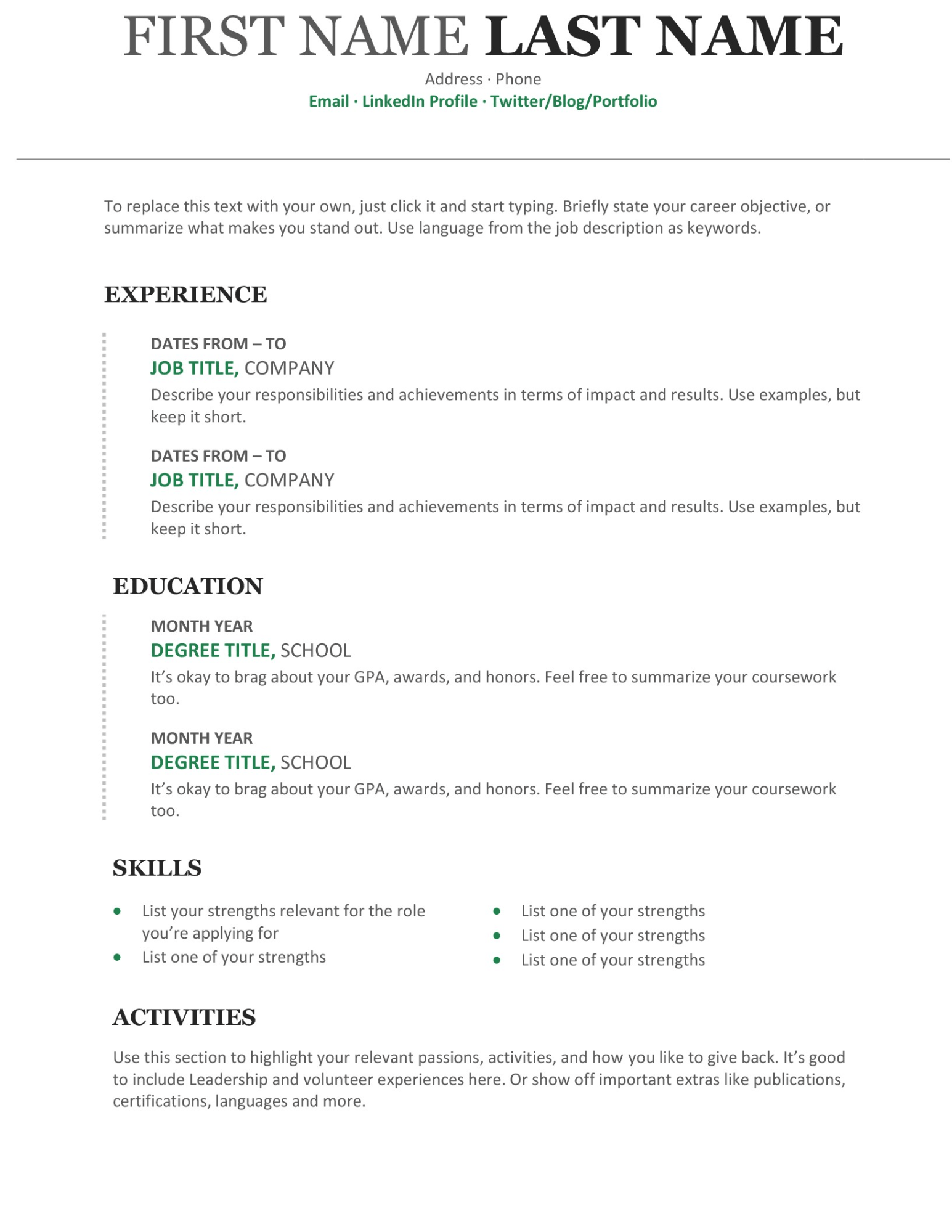
Key Takeaways
Well, here you have it - your nicely tailored resume in Word, ready to land you that job interview.
Although not the easiest task, we are convinced this article has given you all the necessary information on how to make a resume in Word and the confidence to do so easily.
Here’s what’s good to remember:
- Order your resume sections properly, usually in reverse-chronological order.
- Make sure that your section headings stand out from the rest of the text, by usually using a larger font size.
- Check if your chosen font, line spacing, and margins are aligned, readable, and professional-looking.
- Opt for an online resume builder such as the one Novorésumé provides for a more modern, time-saving, and HR-friendly resume.

To provide a safer experience, the best content and great communication, we use cookies. Learn how we use them for non-authenticated users.
- Delete a Page in Word
- Convert PDF to Word
- Page Numbers in Word
- Double Space in Word
- Table of Contents in Word
How to make a resume in Microsoft Word
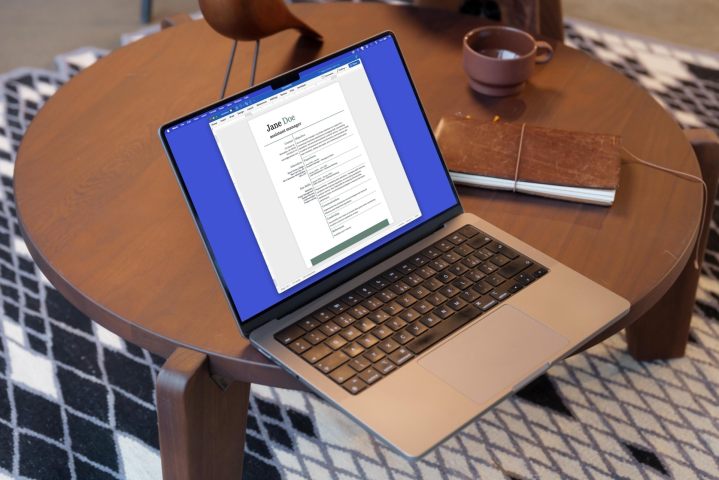
Whether you’re just entering the workforce or need a resume refresh, you’re probably considering Microsoft Word for the task. We’ll walk you through options for making a resume in Word, from using helpful templates to creating a resume from scratch.
Use a built-in Word resume template
Use a word resume template on the web, use a third-party word resume template, create a word resume from scratch.
The quickest and easiest way to make a resume in Word is using one of Microsoft’s templates . You can look for one directly in Word and choose from a large collection of options.
Open Word, select File > New , and pop “resume” into the Search box. You can then browse the templates with resumes for specific jobs and industries along with those for any type of position.
Choose a template to see a description and pick Create to use the resume.
The Microsoft resume templates come with placeholders that you can simply swap out for your own details. This is handy if you like the appearance of all elements in the template. Of course, if you’re not fond of the color scheme or font styles, you can change those types of items.
Remember to go to File > Save As to save a copy of your resume.
Maybe you don’t have Microsoft Word on your computer yet but need your resume in that format. You can use Word on the web for free with a Microsoft account and take advantage of resume templates.
Visit the Microsoft Create website and explore the resume templates . If you see one you like, select it to open it directly in Word for the web.
Alternatively, select Create from scratch and choose Resumes, flyers, brochures . When Word opens, use the Designer sidebar on the right to browse through and choose a resume template.
Then, swap out the placeholders for your own details and customize the resume as you like.
If you like the template idea but don’t care for any of the Microsoft options, you can check out third-party templates for your resume. Here are just a few of the top options and samples of resume templates they offer for free.
Resume Genius
With Resume Genius , you can pick from over a dozen custom Word templates to download. From simple to professional to aesthetically pleasing to visually appealing, you’re sure to find at least one resume template you like.
Hloom offers over 15 resume and CV templates for free and even more if you don’t mind paying. Be sure to select Free on the left below License if you want to narrow down the no-charge options. As a bonus, you’ll also see a tab for cover letters if you’re in the market for one of those too.
Template.net
One more place to check out for Word resume templates is Template.net . You’ll find a large variety of attractive options specific to position or resume style. Like with Hloom, select Free beneath License on the left, and be sure to take a look at the cover letter collection too.
After you download a resume template from one of the above sites, simply customize it with your own details.
Maybe you’d prefer to simply create your resume from scratch; this is always an option if you have the time. Consider reviewing the above templates and samples for the information you should include and ideas for formatting.
To get started, add the following details to your resume:
Full name and current position : Place your name and position at the top. If you don’t have a current position, you can certainly omit it.
Objective (optional) : Provide a brief description of your goal to potential employers beneath your name and position. This is an optional inclusion — if you add one, try to keep it short and sweet with one to two meaningful sentences.
Contact details : Include at least your email address and phone number. If you have an up-to-date website or LinkedIn profile, you can add these as well. Make sure these details are kept together in a specific location so they’re simple to find.
Work experience : List your work experience in chronological order with the most recent first. Start with your position, then move onto the employer, month, and year you worked there, and your duties. You should include your duties and responsibilities in a list format making them easy to review.
Education : List your educational history in chronological order with the most recent first. Start with the degree, then add the school with the month and year you attended.
Skills, awards, and more : Use a list format to add your skills, awards, certifications, volunteer work, and any other details you feel important to the position or company.
Here are several tips when formatting your resume in Word:
- Use a heading or larger font for your full name at the top.
- Add headings for the Experience, Educations, and Skills sections.
- If you decide to use color, keep it to just one or two complementary colors.
- Try to use the same font style throughout, taking advantage of font sizes, headings, or bold formatting for more prominent details.
- Use a font that’s easy to read like a 12-point Arial, Calibri, Georgia, or Times New Roman for the main body text. You might also consider which font style works better for reading on the web versus on a printed piece.
- If you include a headshot, make sure it’s a professional one.
- Consider using a table to structure your resume, as shown above.
Finally, be sure to keep the appearance and content of your resume consistent.
Is it OK to make a resume in Word?
Absolutely! This is exactly the type of document you should create in a word processing application like Microsoft Word. If you prefer, you can also use a web application like Google Docs to make a resume or downloadable software like LibreOffice Writer.
Once your resume is complete, you can save it as a PDF or other requested format in most word processing applications for submission to the potential employer or hiring manager.
How far back should a resume go?
Most experts recommend 10 to 15 years is appropriate for a resume. Keep in mind that you should include relevant work experience for that time period . For example, if you’re a nurse who worked at a fast-food chain for two months 12 years ago, you can likely exclude that job.
How many pages should a resume be?
The standard for a resume is one to two pages. However, this can depend on the length of your experience and education in relation to the position for which you’re applying. For instance, someone who’s been in the workforce for 20 years might require two pages, but a recent college graduate would probably only need one page.
Editors’ Recommendations
- What is Microsoft Edge and how to use it
- How to use Microsoft Word: a tutorial for beginners
- Best Microsoft Office deals: Get Word, PowerPoint, and Excel for free
- It took Microsoft 30 years to change this Windows feature
- How to convert Word into PDF or JPEG
- How-To Guides

Microsoft will soon eliminate OneDrive Business accounts that have remained unlicensed for over 90 days because, as mentioned in a Microsoft Learn blog post, the tech giant feels they pose a significant security threat by leading to confusion and duplication in enterprise environments.
The archiving process will begin in January 2025, and users will not have access to their accounts once they are archived. Those affected accounts will have a $0.60/GB activation fee and a monthly fee of $0.05 per GB for storage in the Microsoft 365 Archive. Once the user pays, the activation process can take as long as 24 hours, but only after following the necessary steps in the Microsoft 365 admin center.
Microsoft is the home of one of the better laptop deals at the moment, with up to $600 off select models of the Microsoft Surface Laptop Studio 2. The discount varies depending on the specification you go for, so essentially the more you spend, the bigger the saving. Models start from $1,900 instead of $2,000 and the highest end option costs $3,100 instead of $3,700. We’re on hand to take you through all the different options available so you can find what works best for you and your budget. These deals will end on August 25. To check out all the Microsoft Surface Laptop Studio 2 options, click the link below or keep reading while we take you through it.
Why you should buy the Microsoft Surface Laptop Studio 2 It wasn’t that long ago that the idea of Microsoft being one of the best laptop brands felt unimaginable. Since then though, its Surface series has easily earned that place. The Microsoft Surface Laptop Studio 2, for instance, is designed for creative professionals so it’s powerful and stylish.
Need to create a mass mailing or bulk email message? In Microsoft Word, you can set up a mail merge that inserts your recipients and their details automatically.
You have two ways to create a mail merge in Microsoft Word. You can use the Mail Merge Wizard, which is great if you’ve never set one up before, or the Mailings tab, which might take a bit more time but allows for additional options.
- PRO Courses Guides New Tech Help Pro Expert Videos About wikiHow Pro Upgrade Sign In
- EDIT Edit this Article
- EXPLORE Tech Help Pro About Us Random Article Quizzes Request a New Article Community Dashboard This Or That Game Happiness Hub Popular Categories Arts and Entertainment Artwork Books Movies Computers and Electronics Computers Phone Skills Technology Hacks Health Men's Health Mental Health Women's Health Relationships Dating Love Relationship Issues Hobbies and Crafts Crafts Drawing Games Education & Communication Communication Skills Personal Development Studying Personal Care and Style Fashion Hair Care Personal Hygiene Youth Personal Care School Stuff Dating All Categories Arts and Entertainment Finance and Business Home and Garden Relationship Quizzes Cars & Other Vehicles Food and Entertaining Personal Care and Style Sports and Fitness Computers and Electronics Health Pets and Animals Travel Education & Communication Hobbies and Crafts Philosophy and Religion Work World Family Life Holidays and Traditions Relationships Youth
- Browse Articles
- Learn Something New
- Quizzes Hot
- Happiness Hub
- This Or That Game
- Train Your Brain
- Explore More
- Support wikiHow
- About wikiHow
- Log in / Sign up
- Job Application Documents
- Resume Preparation
How to Create a Resume in Microsoft Word
Last Updated: September 25, 2023 Approved
This article was co-authored by Alyson Garrido, PCC . Alyson Garrido is an International Coach Federation accredited Professional Certified Coach (PCC), Facilitator, and Speaker. Using a strengths-based approach, she supports her clients with job search and career advancement. Alyson provides coaching for career direction, interview preparation, salary negotiation, and performance reviews as well as customized communication and leadership strategies. She is a Founding Partner of the Systemic Coach Academy of New Zealand. wikiHow marks an article as reader-approved once it receives enough positive feedback. In this case, several readers have written to tell us that this article was helpful to them, earning it our reader-approved status. This article has been viewed 1,638,595 times.
Resumes detail a person’s work experience, education, skills and achievements. A good resume that is clear, concise and easy to read is essential when looking for a job. Resumes should be word processed and should be neat and tidy. Microsoft Word offers you the option of creating your resume through templates, but you can also create your resume from scratch using Word's formatting features.
Sample Resumes

Creating a Resume from a Template (Word 2003, 2007, 2010, 2013)

- In Word 2007 you will have to click on “installed templates.”
- In Word 2010 it will be “sample templates.”
- In Word 2011 it will be “new from template.” [1] X Research source
- In Word 2013 the templates will be displayed when you click on “New.”

- In Word 2013, after clicking on “New” you will see a number of templates and a search bar which says “search for online templates.”
- After searching you will see a number of different resume templates to try out.

- Here you will be able to look through a number of templates for resumes and cover letters that you can download for free and edit in Word.
- You may have to sign in with your Microsoft online account to use these templates. [2] X Research source

- Be sure to look carefully at the detail of your resume and proofread it thoroughly.
- All of the versions of Word from 2003 to 2013 all come with some pre-installed templates for resumes.

- Click on the “Other Documents” tab, and then select “Resume Wizard.”
- Follow the wizard's instructions. The wizard will walk you through the resume creation process step-by-step
- If you do not see this option, it was not installed when you installed Word, and you will need to run the installation program again to install it.
Creating a Resume Without a Template

- Education and qualifications.
- Work and volunteer experience.
- Skills and qualities.
- It should also include your full contact details and state that references are available upon request.

- Most chronological resumes only cover the last 5 to 10 years of your employment history.
- You may wish to include positions earlier than this if they are appropriate to the job you're seeking.
- This is the format most American employers prefer to see resumes in.

- A combination resume might list your key skills at the top before providing a short account of your experiences.
- This type of resume can be helpful for those entering the job market with little work experience, or for those trying to change careers. [6] X Research source

- The CV is commonly used when applying for positions in Europe, and also when applying for positions at colleges and universities worldwide.
- CVs can be thought of as living documents that records all your work and achievements, which will generally grow and develop over time more than a resume. [7] X Trustworthy Source University of North Carolina Writing Center UNC's on-campus and online instructional service that provides assistance to students, faculty, and others during the writing process Go to source
Writing Your Resume

- If your resume extends beyond one page, ensure that your name is in a header on every page.
- Your email address should appropriate for a job application. Use your own name or initials if possible.
- Don’t use something jokey such as "sly-dude," "foxymama," or "smokinhot."

- For example, you might write that your objective is “To contribute to the design of new word processing software.”
- Alternatively it may state the position you hope to attain, such as “A position as in healthcare policy and research.”
- Objectives have become less common, and you may prefer to provide this information in your covering letter . [8] X Research source

- You can include a bullet point or two to provide a little further information on your specialism, if it is appropriate for the position you are applying for.
- If you achieved any honours or awards as part of your studying or training include these here.

- Use bullet points to make sure it is clear and easy to read or scan through for key words relating to the position you are applying.
- You can include volunteer positions if they relate to the job you're seeking or if you have little paid experience. [9] X Research source

- You can title this section as “Other Relevant Skills”, or just “Skills.”
- This could include proficiency in foreign languages, knowledge of particular computer software and programmes, and any other specific skills not previously mentioned. [10] X Research source
- Take care to avoid repeating yourself. You don’t need to say you have “excellent communication skills” more than once.

- Allow reasonable margins around the edges of the page. Word's default settings are usually sufficient for this.
- Left-align your section headings. You can use single-spacing after a heading and before the section content, and double-spacing before a heading.
- Get your resume down to one page if at all possible. You can try adjusting your line spacing in the Paragraph dialog box, but don’t lose your neat formatting trying to get it down to one page.
- Rethink your words and try to express yourself more concisely.
Expert Q&A

- Don't wait until you're looking for work to update your resume. Any time you have a promotion or significant accomplishment, add the new information to your resume. Thanks Helpful 5 Not Helpful 1
- Always tailor your resume to the type of position you're seeking. You may have to add, rearrange, or delete accomplishments or entire sections according to what the position requires. Thanks Helpful 6 Not Helpful 2

- The appearance and format of your resume is a reflection of your competence; be sure it represents you at your best. Thanks Helpful 5 Not Helpful 1
- Be sure that all the statements in your resume are both factually and grammatically correct and that all words are spelled correctly. Thanks Helpful 4 Not Helpful 1
You Might Also Like

- ↑ https://kb.iu.edu/d/agst
- ↑ https://templates.office.com/en-us/Resumes-and-Cover-Letters
- ↑ http://cla.umn.edu/student-services-advising/career-internship-services/job-search-resources/resume-guide/formatting-0
- ↑ http://writingcenter.unc.edu/handouts/curricula-vitae-cvs-versus-resumes/
- ↑ http://www.career.cornell.edu/story/resumes/parts.cfm
About This Article

1. Open Word and click File . 2. Click New . 3. Click a resume template. 4. Type your own data into each field. 5. Save your resume as a new file. Did this summary help you? Yes No
- Send fan mail to authors
Reader Success Stories
Jan 19, 2017
Did this article help you?
Asrar Ahamed
May 16, 2020
Amisha Khatri
Nov 23, 2016
Jan 9, 2017
Aug 12, 2017

Featured Articles

Trending Articles

Watch Articles

- Terms of Use
- Privacy Policy
- Do Not Sell or Share My Info
- Not Selling Info
wikiHow Tech Help Pro:
Level up your tech skills and stay ahead of the curve
How to Use a Template to Make a Stellar Resume in Microsoft Word (Plus Examples to Get You Started!)

You’re probably familiar with the terror of staring at a blank document and seeing that blinking cursor just waiting for you to start writing, whether you’re thinking of long gone school assignments or that report you had to submit to your boss yesterday. And when it comes to your resume—the document that stands between you and your next job—the stakes can feel particularly high.
The good news is that you don’t have to start from scratch when you’re writing a resume. There are plenty of resume templates out there that you can use. And since starting with a template eliminates a lot of formatting and spacing decisions, you can focus on the content of your resume so that you can get your foot in the door and get hired.
The bad news is that then, very quickly, your first problem (the blank document) becomes an entirely new problem: How in the world do you choose the right template?
Starting with Microsoft Word is a smart move. According to Amanda Augustine, a career expert and resume writer for TopResume , files that end in “.docx” are the safest to submit to an applicant tracking system (ATS), the software that companies use to organize and analyze applications and identify the most promising candidates for a given role (often before a human is ever involved). Since .docx is the format that’s compatible with systems across the board—and some systems still can’t properly parse .pdf and other formats—it can be to your advantage to work in Word.
Here’s everything you need to know about finding, picking, and using Microsoft Word resume templates—plus a few examples of templates you can use for free (or cheap!).
How to Find Word Resume Templates
How to choose the right word resume template, how to use a template to make a resume in word, 7 microsoft word templates to use as starting points.
You can find free Word resume templates right in the program—in recent versions by clicking on “File” > “New From Template” and scrolling through or searching for “resume.” You can also search for resume templates offered by Microsoft Office online here .
If you’d like a Word template but not necessarily one that comes directly from Microsoft’s library, you can turn to Jobscan, Hloom, and other sources for free templates or pay for one on sites like Etsy. Some career coaches offer original templates on their websites, too (you can find Muse career coach Jena Viviano’s templates here , for example).
When you first start searching for a template, the number of options can feel overwhelming. How do you know which one to pick?
The most important thing to keep in mind is this: Just because a template is in Microsoft’s library or is available online, that doesn’t mean it’s a good template that will help your resume pass through an ATS and appeal to recruiters and hiring managers. “Oftentimes they’re developed because they look really cool and really slick and you’re attracted to them,” Augustine says.
But not all templates are created equal, warns Jon Shields, Marketing Manager at Jobscan . “Some of them are pretty good and some of them are really bad.” Here are some tips to help you tell the difference:
1. Pick a Layout That Works for You
Resumes, like jobs, are about fit as much as anything else. So beyond good and bad, you’re looking for a template that makes sense for who you are and what your goals are.
Your first step is to pick an overall resume format— chronological , combination (also called hybrid), or functional . (If you have no idea which one is right for you, check out our guide to deciding here .)
The chronological and combination formats both work well for an ATS as well as for recruiters and hiring managers, but beware of the functional resume. Besides tripping up the ATS, which generally isn’t programmed to parse your information in that order, functional resumes “are really loathed among recruiters and hiring managers,” Shields says, because they “make it difficult to understand your career trajectory and where you developed your skills.”
You should also think carefully about what you’ll be able to put “above the fold,” or in the top third or half of the document. People tend to focus more attention there so it “needs to be a snapshot of everything they really need to know about you,” Augustine says. Ask yourself, she says, “What’s most relevant about your past that applies to the current job?”
If you’re still in school or a recent grad, for example, you might want a template where you can put your education at the very top, or you might opt for one that lets you emphasize your great internship from last summer. If you have a great deal of experience, on the other hand, you might want a template that lets you start off with a resume summary or a section pinpointing key achievements. And if you work in a technical field, you might want to put a skills section up top to highlight the software you’ve used or the languages you code in.
While it might be easiest to find a template that’s already set up with the exact sections you want in the exact spots you want them, remember that you can also tweak any template to suit your needs.
If it’s not immediately clear to you which direction to go in, that’s OK! Shields recommends trying out a few different templates and seeing which one presents your experience in the best possible light.
2. Make Sure There’s Enough Space
In some cases, a template “looks really nice, but it doesn’t actually give the space you need in order to properly give your previous experience the attention it deserves,” Augustine says. Sure, you should be succinct, but you also want to have room to include your most important points without shrinking the font down to an illegible size.
At the same time, you want to pick a template that’s clean and has some white space, says Viviano. You don’t want to end up with a resume that’s too “jam packed with words.”
3. Don’t Get Too Fancy
Though you might be drawn to splashy, quirky resume templates, it’s actually best to choose a simple and relatively conservative design—even in creative fields. While a little bit of color can be a great way to make your resume stand out, for example, you probably don’t want to pick a template that yells and screams with 17 different bold colors. You’ll also want to stick to just one or two fonts.
And stay away from bubbles, stars, bar charts, or other meaningless ways to measure your proficiency in various skills. “Unless it’s a standard scoring or grading system that’s used, it just seems subjective,” Augustine says. “It's not actually helping the reader truly understand your competency.”
Most importantly, avoid templates that get too creative with where you’re putting important information and how you’re presenting it. Both the ATS and any humans looking at your application “want resumes that are very clearly and easily interpreted so there’s no confusion as to where key information is located and what each section means,” Shields says.
That means keeping with conventions. “In a lot of cases, simple is better,” Augustine says. “The ATS aside, recruiters are used to looking for information in certain areas, and if you decide to go rogue and start putting things in different spots, it’s not necessarily going to mean, ‘Oh that recruiter is going to spend extra time looking at my resume for that information,” she says. “They’re going to quickly glance, not see what they want, and move on to the next.”
4. Look Out for ATS Blockers
An ATS often acts as a gatekeeper for human recruiters or hiring managers by doing a first screening of applications. Once the system identifies the top prospects based on the keywords and other signals it’s programmed to pick up on, a human might not reach beyond that pile. So you want to look out for red flags that might prevent your resume from making it through the first hurdle. Pay attention to:
- Headers and Footers: You never want to put any information in the actual header and footer sections of your Word document, Augustine says, because it doesn’t always get parsed correctly (or at all) by an ATS.
- Section Titles: Make sure you label your sections clearly and simply, no matter what the original template had. “If you get too outside the box with that, those parsing algorithms that pull that information into a digital applicant profile start getting confused,” Shields says. If the system is programmed to look for a section titled “Work Experience” or “Professional Experience,” and another section titled “Education,” the ATS might not recognize any unorthodox labels you’ve used and won’t know what to do with the information below them.
- Images and Graphs: An ATS will basically ignore any images, Augustine says, so you’ll want to avoid using them—especially as a fancy way to include your name or any other vital information.
- Text Boxes: Although you’re entering words into a text box, it’s “considered an object so it won’t get parsed properly,” says Augustine.
- Hyperlinks: If you add a link to a string of words in one of your bullet points, there’s a chance the ATS will only parse the URL and ignore the actual words, Augustine explains. So make sure to hyperlink from “(link)” or “(website),” not from important text like “increased by 25%” or “resulting in $5 million in revenue.”
- Columns: “A lot of ATSs struggle to parse text side by side,” Shields says. “It will read from left to right regardless of column dividers, mashing up content from two unrelated sections.” That’s one more reason to lean toward “more classic-looking resumes that don’t have tables and columns,” he says. While some systems may be able to read some kinds of columns, according to Augustine, it’s safer to stay away.
- Fonts: Look for a template that uses a relatively common font. Not only will humans appreciate a clean, clear font, but an ATS can’t always read custom or obscure fonts. Augustine says both serif and sans serif fonts can work, and safe fonts include (but aren’t limited to): Calibri, Arial, Trebuchet, Book Antiqua, Garamond, Cambria, and Times New Roman.
- Frames: Putting a box or frame all along the perimeter of your resume is a “big ATS no-no,” says Augustine.
Of course, you can always make changes to an existing template. So if there’s a frame, you can simply delete it. If the spot for your name is in the header, you can move it into the body. Or if the font is obscure, you can change it to a more common one.
In other words, you don’t have to reject a template out of hand because it contains one of these elements. But you might want to avoid a template that has so many ATS blockers that you’ll have to perform formatting gymnastics just to get it to a usable baseline.
5. Avoid Photo Resume Templates
Shields has noticed template websites trending toward photo resumes, which are common in many countries around the world. However, U.S. job seekers should avoid including a headshot, Shields says, for the sake of both the ATS and the humans who might review your application.
On the tech side, an ATS won’t be able to parse an image, so the best case is that it’ll simply get dropped when the system is creating your digital profile. But the more concerning scenario is one where the image causes formatting issues or parsing errors that could impact how a system reads the rest of your resume.
And aside from the ATS, “we’ve heard firsthand from a lot of recruiters that won’t even review applicants that submit a photo,” Shields says. “They just can’t make themselves more vulnerable than they already are to any possible claims of discrimination.” And you don't want to open yourself up to actual discrimination, either.
The bottom line, Viviano says, is that unless you’re a model or actor, your photo doesn’t belong on your resume. In essence, you’re “taking up a lot of real estate on your resume [with something] that shouldn’t have a part to play in who hires you.”
Okay, so you’ve found a template or two that you really like and you’re ready to sit down and make your resume . What now?
1. Gather All Your Info
“Before you start, take some time to actually collect all the information that could possibly be used for writing your resume,” Augustine says.
If you have a previous resume you’re working off of, make sure you have it on hand. You can also sit down and create a document that includes every single past job, skill, and accomplishment that you can use as your well to draw from. Or you can fill out this worksheet . Once you have all your content, it’ll be easier to plug it into the template seamlessly.
2. Don’t Be Afraid to Tweak the Template
Templates aren’t set in stone. Remember, you can and should adjust as needed to make a template work for you.
For starters, you’ll still see a lot of templates out there that still include sections for an objective statement or for your references, even though both are outdated elements that no longer belong on your resume.
It’s fine if you have your heart set on a template that happens to have these sections, but make sure you delete them or transform them. A section for an objective could easily become space for a resume summary, for example, or be used to list your key skills, while a references section could turn into a volunteering or awards section.
Beyond getting rid of antiquated sections, you can make any change you think will help you present the best version of yourself for the role. “A resume template can serve as a great guide, but sometimes they’ll do more harm than good if you’re bending your experience to match the template rather than the other way around,” Shields says. “So if you don’t have anything for a particular section that’s in the template, remove it. If you want to add some additional information that you think strengthens your case, add it in,” he says. “Just be careful to keep formatting consistent and focus on that readability.”
Suppose you find a template you love that dives into work experience, but you’d really like to highlight your key skills at the top. Feel free to add another section using the same header font and style. On the flipside, if you’re using a template that has an awards and acknowledgements section, but you’d much rather showcase your volunteering experience or additional skills, go ahead and change it.
Remember too that a template is, well, just a template. “It’s giving you a framework to work with,” Augustine says, but you’ll still have to put in the effort to decide which accomplishments and skills to highlight and how to craft your bullet points in the best way.
3. Paste or Write in Your Info
When you’re finally ready to put all of your work experience and accomplishments into the template and make it yours, Viviano recommends that you “complete the easy things first,” like your name and contact info and your education. “It’ll be like a quick win.” Then continue on to fill out the rest.
Make your life easier later by pasting in your information as text only—without the formatting it had on your previous resume, in your prep doc, or in the worksheet you filled out. Use this copy-and-paste trick to make sure everything you drop in there matches the formatting of the template. Otherwise, you might “spend a ridiculous amount of time trying to get spacing right again,” Augustine says.
Finally, make sure you’ve replaced or deleted all of the dummy text and any instructions that were in the template when you got it!

4. Test How It’ll Fare in an ATS
If you want to test how your new resume will hold up when it goes through an ATS, you can try one of two things:
Copy everything in your Word document and paste it all into a plain text document. “If certain things turn into weird characters,” Augustine says, if the sections are nowhere near where they should be, or if everything’s out of order, “that’s probably what would happen if goes through parsing.”
Run it through an online tool such as Jobscan or request a free critique from a service like TopResume .
5. Reread and Proof It!
Typos and spelling mistakes are often deal breakers for recruiters, according to Augustine. And it’d be a shame to get dropped in the “no” pile for little mistakes. So make sure you proofread your resume—maybe twice, and maybe after stepping away from it for a few hours—and see if you can hand it off to a friend or family member to take a look with fresh eyes.
Reading your resume over as a complete document is also an opportunity to imagine the first impression you’ll make. “A lot of people...get so caught up in editing a resume and making sure it’s so optimized that it becomes this robot-like resume,” Viviano says. So as you’re reading, consider: Does it sound like a human wrote it? What story are you telling? Is it obvious you’d be a great fit for the specific role you’re applying for?
Still having trouble actually picking a template after all that? Here are a few that can work—we’ve added tips for how to improve and customize each one.
1. Resume Genius’s Dublin Template
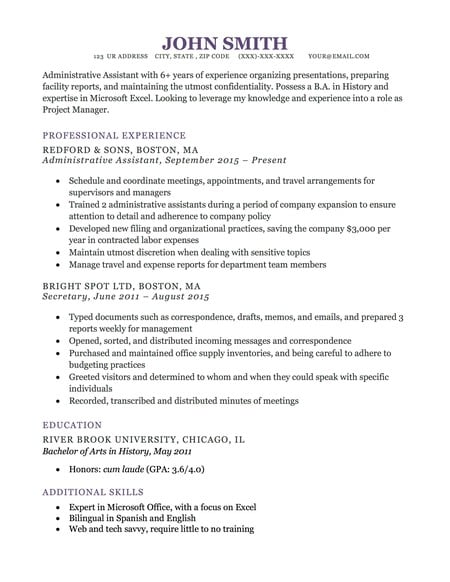
Who might use it? Anyone looking for a traditional chronological resume!
- You don’t need to include your full address (just a city and state will suffice).
- Add your LinkedIn profile alongside your other contact info so that the recruiter or hiring manager can head to your page and find additional information about your experience, see glowing recommendations you’ve received, look at work samples you’ve posted, and get excited about you as a candidate. (Just make sure your profile is updated !)
- Don’t include your GPA unless you’re a recent grad and it’s impressive.
Download it here .
2. JobScan’s Recent Grad 1 Template
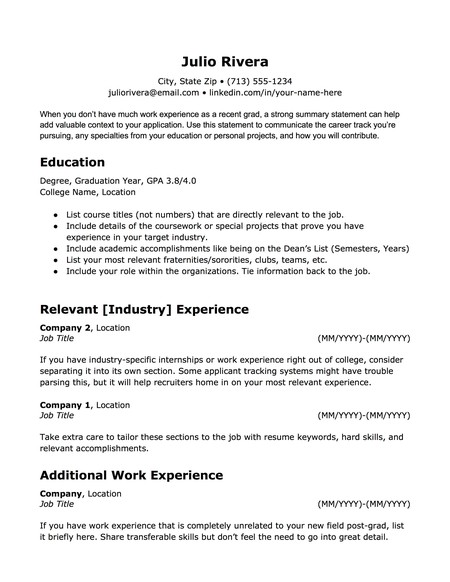
Who might use it? A recent grad who has internship or work experience that’s relevant to their target field or role as well as other experience.
- You don’t need to include your zip code.
3. Microsoft Office’s Basic Resume Template

Who might use it? A recent grad who doesn’t have a ton of work experience.
- Put your name all on one line (instead of two lines, as in the default) to ensure the ATS captures your full name.
- Try to differentiate the section headings from each job and education entry by changing the font size or style.
- Add your LinkedIn profile next to your contact info and remember you don’t have to put your full address (just a city and state will suffice).
Find it in Microsoft Word.
4. Get Landed’s ATS-Friendly Resume Template
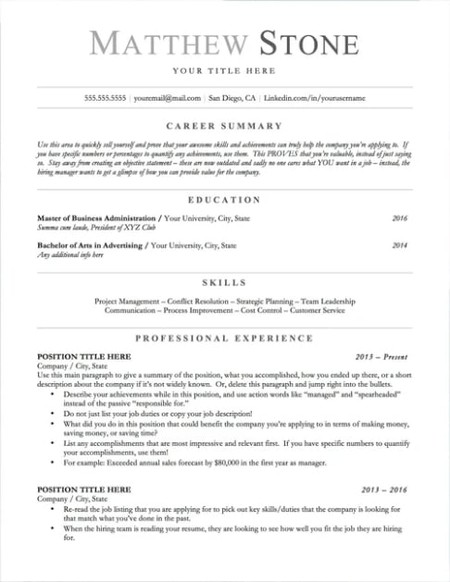
Who might use it? Someone looking for a template that could easily be tweaked as a chronological or combination resume, depending on where you put that skills section.
- Unless you’re a recent grad, you probably shouldn’t have your education up so high.
5. ResumeByRecruiters’ ATS Resume on Etsy
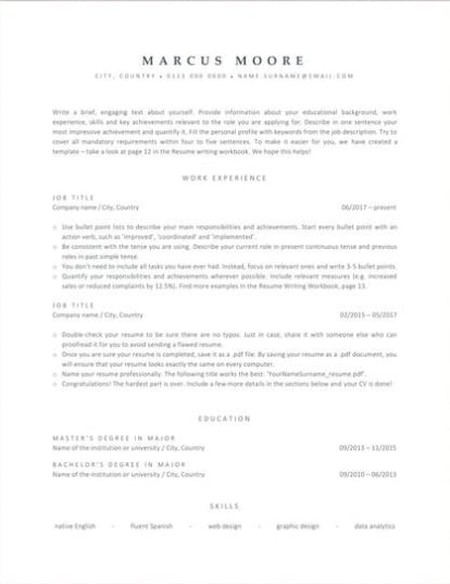
Who might use it? Someone looking for a template that could easily be tweaked as a chronological or combination resume (by moving up the skills section to the top).
- Add your LinkedIn profile alongside your contact info.
Cost: About $12
6. JobScan’s Classic Chronological and Hybrid Templates
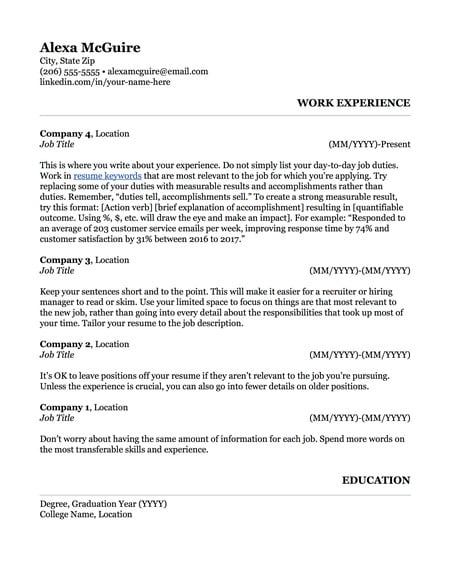
Who might use it? Someone looking for a simple template with no frills.
- Try to make sure you fit everything on one page.
Download them here .
7. Resume Genius’ White House Template
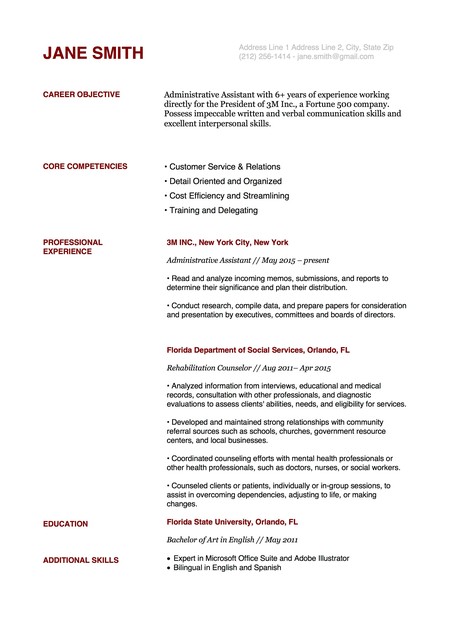
Who might use it? Someone looking for a template with a lot of white space.
- You don’t need a full address; city and state is enough.
- Add your LinkedIn profile.
- Do not use a resume objective section. You can replace that with a summary or get rid of it entirely.
Explore Jobs
- Jobs Near Me
- Remote Jobs
- Full Time Jobs
- Part Time Jobs
- Entry Level Jobs
- Work From Home Jobs
Find Specific Jobs
- $15 Per Hour Jobs
- $20 Per Hour Jobs
- Hiring Immediately Jobs
- High School Jobs
- H1b Visa Jobs
Explore Careers
- Business And Financial
- Architecture And Engineering
- Computer And Mathematical
Explore Professions
- What They Do
- Certifications
- Demographics
Best Companies
- Health Care
- Fortune 500
Explore Companies
- CEO And Executies
- Resume Builder
- Career Advice
- Explore Majors
- Questions And Answers
- Interview Questions
How To Make A Resume In Word (With Examples)
- How To Write A Resume
- Free Resume Templates
- How To Build A Resume
- Specific Resume Words
- Action Verbs On A resume
- Words To Describe Yourself
- Resume Outline
- How To Make A Resume
- How To Make A Resume On Word
- How To Write A Resume Profile
Writing a professional, polished resume can be easier said than done, but using the right tools will make this task a lot simpler. One of these tools is Microsoft Word and the many resume templates it provides.
In this article, we’ll talk you through how to write a resume in Microsoft Word, and why and how you should use its resume templates.
Key Takeaways
The first steps to writing a resume in Word are to choose a template and to enter your name and contact information.
Using a Word resume template will make it easier to format your resume correctly.
Even when using a template, you should tailor your resume to each position you apply for.
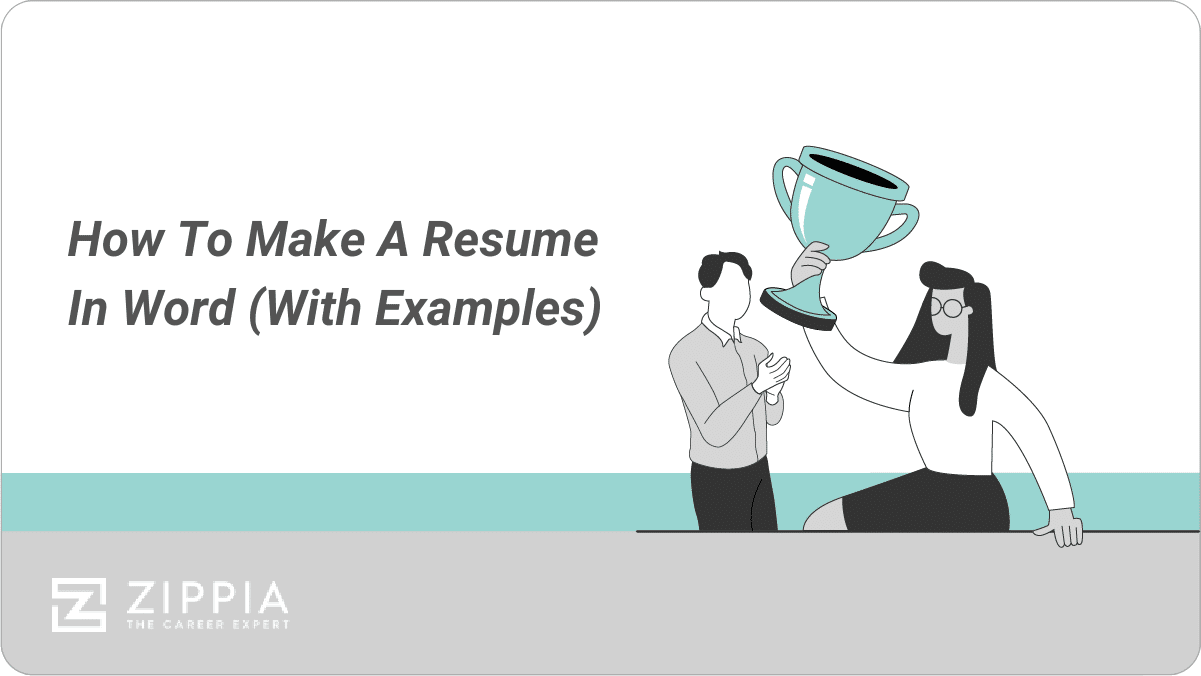
How to Write a Resume in Word
Why use a resume template, where to find a word resume template, tips for writing a resume in word, the importance of a great resume, final thoughts.
- Sign Up For More Advice and Jobs
Choose your template. Choose a Microsoft Word resume template that looks professional and matches your resume needs. You don’t have to like everything about it, but you should like the general structure.
Enter your name and contact information. Now that you have your resume template chosen, fill in your information. Anything that is in brackets ([]) should be replaced with your information and the brackets deleted. Make sure you change the contact information ; if the hiring manager cannot reach you, all of this work will have been for nothing.
Write a summary statement. Write a sentence or two about your top skills and what you’d add to the company. This is your opportunity to entice hiring managers to keep reading by pointing out what makes you the perfect person for this job.
List your work experience. Keep in mind the short time you have to convince your reader , and list only relevant job experience ; this will help you keep your resume to only one page and will help you keep the hiring manager’s attention.
When listing job experience, you can choose to list it chronologically, by most recent job to least recent. Or you can choose to list your job experience functionally, meaning you list jobs that gave you valuable experience that you will use in the position you’re applying to, with the most valuable being listed first.
For example, if you’re applying to a digital marketing job, you would list all of the jobs that gave you digital marketing experience and choose not to list a customer service position you may have worked recently.
Here are some additional tips for listing your work experience:
Include the dates you worked. You do not have to be specific, but usually, the month and year are included with a job title, such as “July 2016 – September 2019.”
When describing your responsibilities in a position, try to list only those that are relevant to the position you’re applying to. Even if you had more responsibilities, do not list them unless they speak to the abilities you would use in this position. By listing only the relevant responsibilities, you are more likely to keep the recruiter ’s attention.
Keep your descriptions active, and avoid passive language. This means it is better to write, “managed inventory,” rather than “inventory was managed.”
Try using figures, if they are relevant. For example, you can talk about the number of employees you managed, so the hiring manager understands the scale of your responsibility. You can also choose to emphasize specific accomplishments you made while in a particular position, such as a particular project or an obstacle you overcame.
Add your educational background. Whether you have a high school diploma or an advanced degree, put it on your resume (only include your high school diploma if you don’t have a degree, though). Include your areas of study, the date you graduated or are expecting to graduate, and any academic honors.
Add your skills. Create a separate section and list your applicable technical skills. You can also include your soft skills, but try to focus mainly on the hard or technical skills.
Tailor your resume to each position you apply for. If you are applying to multiple positions at once , consider creating a resume for each position, tailoring each document to best highlight the skills that position requires. To keep the resumes organized, consider saving the file as “Resume_CompanyName,” or something similar.
A resume template is a great way to ensure that your resume comes out looking its best and helps the hiring manager quickly find out what makes you qualified for the position.
You can find a design that reflects your personality and brand. There are many kinds of templates, ranging the gamut from colorful and casual to business-like and formal, so everyone can find a template that fits their needs.
It makes it easier to format your resume correctly. Using a template can also help cut down on confusion, as we sometimes receive contradictory advice on how to write a resume.
An easy-to-use template helps guarantee that your resume always has what hiring managers are looking for, with proper formatting and without errors, allowing you to make the best first impression you can.
It may come with a cover letter template. Sometimes, resume templates also come with matching cover letter templates , so you can make use of these if an application calls for one, or if you want a chance to explain, in your own words, why you would be a great fit for the position.
It helps you avoid writer’s block. Templates can serve as a jumping-off point, allowing you to create the first draft of your resume, before adjusting it to better fit your needs.
You can choose to use as much of the template as you want, whether you want to use it as just a bare-bones outline, or if you want to fill in every blank you are given.
If you’re using Microsoft Word, it is easy to find resume templates.
Open Word, and on the left side of the screen choose “New” to create a new document. For advice on using a Google Docs template, click here .
Next, use the search bar to search for resume templates. Word will supply you with dozens of online templates to choose from. Scroll through the results and find one that is appealing to you, but also appropriate for the job you’re applying to.
Ask yourself where the eye goes first when viewing the document. If it does not go to the most important information, you may want to try another template. Don’t overdo it on color, as this will just distract from the information you want the recruiter to see. Keep graphics professional-looking and minimal.
Choose your template, and click “Create.” Feel free to play around with several templates before deciding which one is right for you. You can also use the template for inspiration if you want to create your resume from scratch .
Do not leave in any brackets. Or any indication that you are using a template. Doing so can leave your resume looking rushed or incomplete, which reflects poorly on you. Make sure to do a few proof-reading before sending in your resume. Maybe have a friend or family member look it over.
Personalize each resume. Tailoring the resume for the job you’re applying to is a great way to make sure you’re putting your best foot forward. Highlight the skills that you could bring to the position, and list any relevant experience.
Talk yourself up. This is your chance to show what you know and talk about what you’re good at. It can be difficult for some of us to write this way, but it is important to describe yourself in the best possible light. Don’t be afraid to brag a little.
Use a skills section. Many resume templates include a sidebar or summary section, which is a place for you to list off your most useful skills .
Research how to write a resume. If you’ve never written one before, using a template as a starting point can be confusing, especially if you don’t know what recruiters are looking for.
A resume is a means of introducing yourself to a potential employer, laying out what you’ve done, what you’re good at, and why you’re a good fit for the position. This is where you make a good first impression . A great resume gets the recruiter interested in you, which can lead to more interviews and more chances to get the job.
Studies have shown that the average recruiter will give your resume no more than a glance, which means you have to sell yourself fast. Hiring managers have to sift through an astronomical amount of resumes, and they will get bored of having to read the same qualifications over and over.
To make yours stand out, only include the important stuff. Think about your resume as if it is a billboard, and you have until the recruiter’s car passes you to prove that you’re right for the job. Because of this, the resume that will get you the most results is one that is organized, easy to read, and direct.
It can seem nearly impossible to create such a lasting impression in so short a time, but luckily there are templates you can use to help you create a flawless resume.
Resumes, ( a.k.a CV, résumé, or resumé ), are a single sheet of paper that gives hiring managers and recruiters a quick summary of your experience, education, and skills.
It is the document that is meant to sell you as a potential employee and convince the reader that you’re the perfect fit for the job .
Writing a resume can seem daunting, especially when we consider just how much rides on having a perfect resume.
However, through the use of templates, you will be able to easily create a resume that will faithfully portray your skills while grabbing the attention of any hiring manager or job recruiter .
How useful was this post?
Click on a star to rate it!
Average rating / 5. Vote count:
No votes so far! Be the first to rate this post.

Chris Kolmar is a co-founder of Zippia and the editor-in-chief of the Zippia career advice blog. He has hired over 50 people in his career, been hired five times, and wants to help you land your next job. His research has been featured on the New York Times, Thrillist, VOX, The Atlantic, and a host of local news. More recently, he's been quoted on USA Today, BusinessInsider, and CNBC.

Related posts
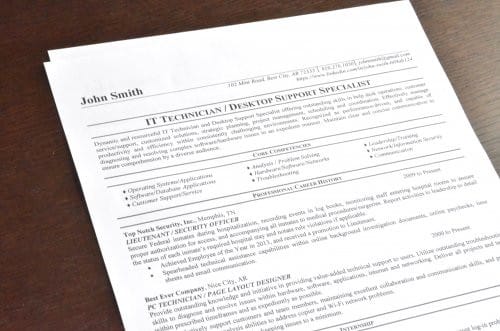
How To Quantify Your Resume (With Examples)
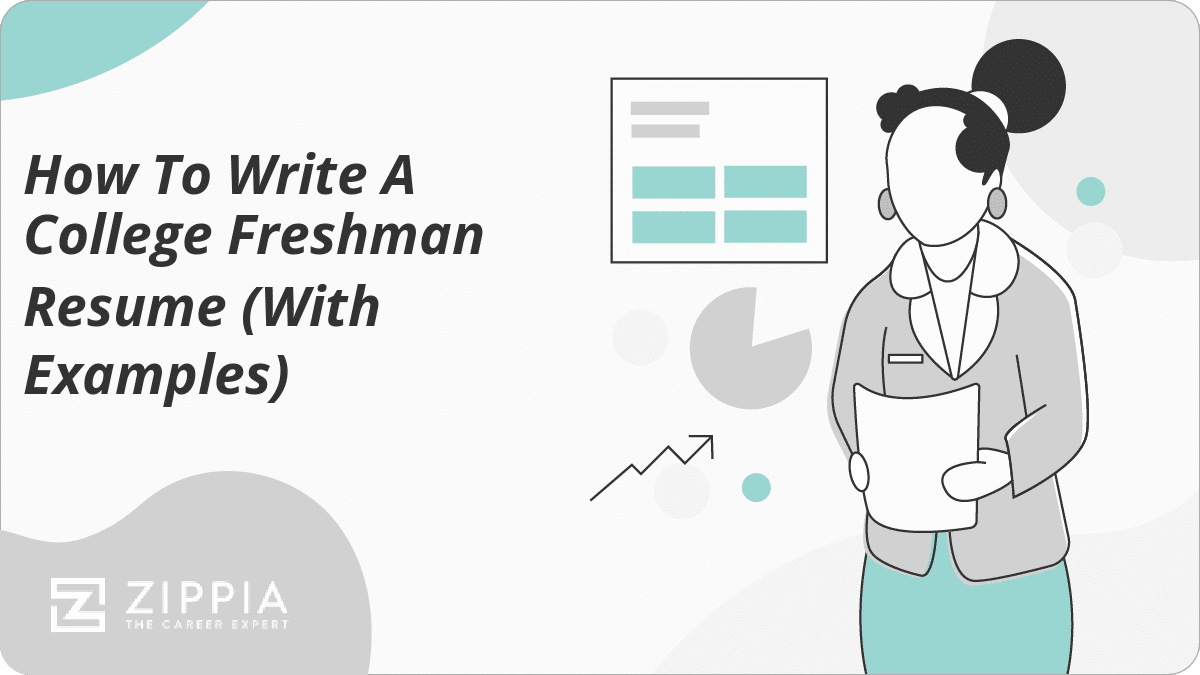
How To Write A College Freshman Resume (With Examples)

How To Put Magna Cum Laude On A Resume (With Examples)
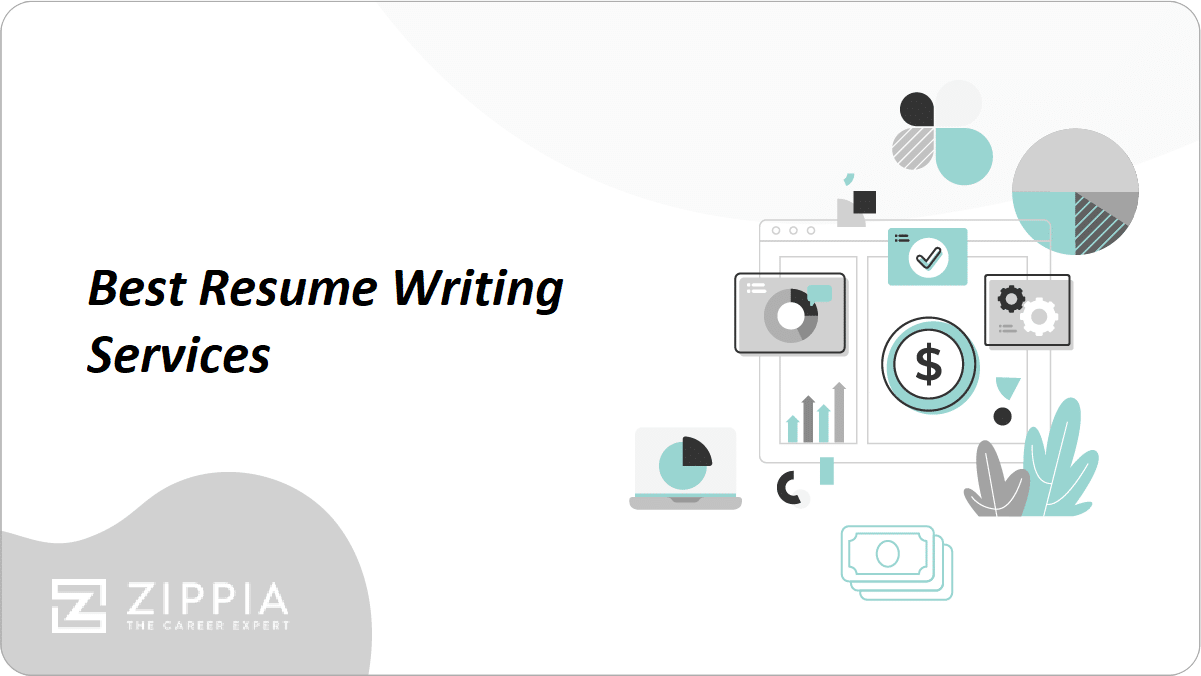
Best Resume Writing Services
- Career Advice >
- How To Write A Resume >
- How To Make A Resume In Word

Use a template to create a resume
If you need help creating a resume or cover letter, start with one of the dozens of professionally-designed resume and cover letter templates that are available in Word.
Go to File > New .
In the search box, type Resume or Cover Letter.
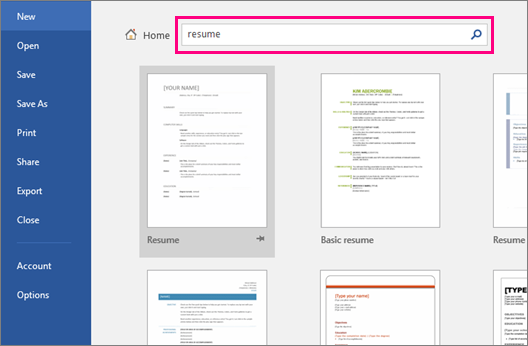
Double-click the template you want to use.
Replace the placeholder text with your own information.
On the File menu, select New from Template .
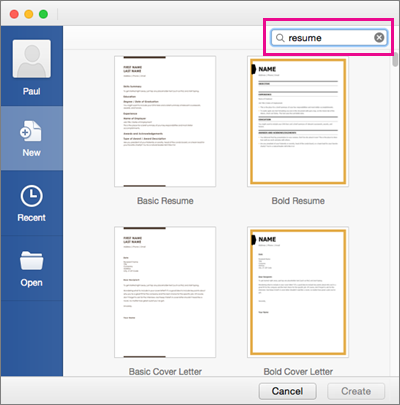
Create and use your own template in Office for Mac
Making a resume like this while you're online is quick and easy.
Note: This template comes with a cover letter, so you'll have everything in one document.
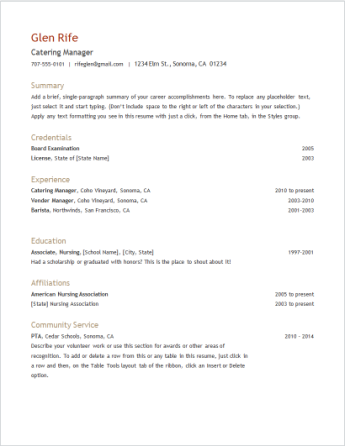
Choose one of our resume templates , and open it in Word for the web to make it yours.
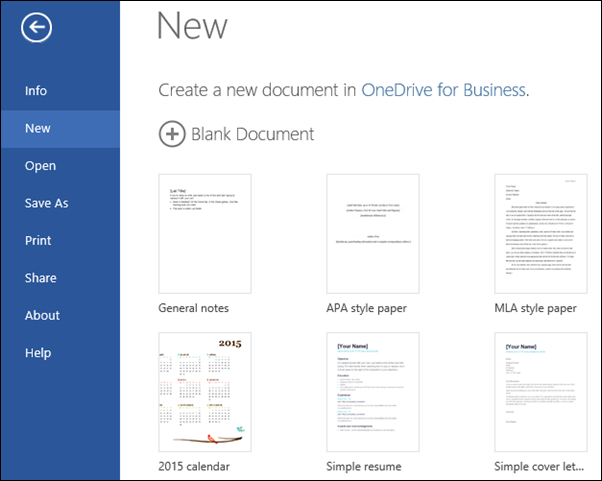
As you work on the resume, you'll probably want to rename it.
The template uses a table to line everything up. If you need to add more lines for job experience or education, add rows to the table by going up to Layout under Table Tools and clicking Insert Below (or Insert Above) .
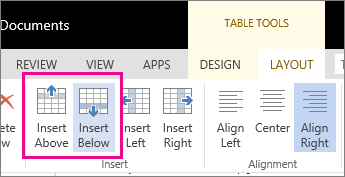
For tips on writing your resume, check out Six steps to developing a great resume .
When you're finished, print it out or share it online. You can do this with the resume still open in Word for the web. No need to save it first (that's already done for you).
To print it, press Ctrl+P, and wait for the Print dialog box.
Note: If you don't see a Print dialog box, click the link for opening a PDF version of your resume. From there, use the PDF program's Print command.
To share it online, send a link:
Near the top of the screen, click Share .
Under Share , click Get a Link .
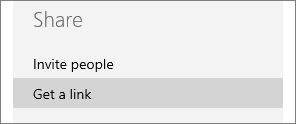
Under Choose an option , click View only .
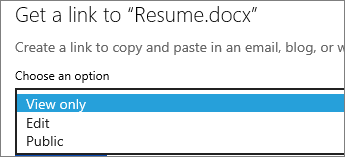
Click Create Link .
Click on the web address to select it, and then copy and paste it into an email, message, or post.
Tip: If you have a blog or website, you can embed a view of your resume there.

Need more help?
Want more options.
Explore subscription benefits, browse training courses, learn how to secure your device, and more.

Microsoft 365 subscription benefits

Microsoft 365 training

Microsoft security

Accessibility center
Communities help you ask and answer questions, give feedback, and hear from experts with rich knowledge.

Ask the Microsoft Community

Microsoft Tech Community

Windows Insiders
Microsoft 365 Insiders
Was this information helpful?
Thank you for your feedback.
195 Resume Power Words That Will Get You Hired (+ Examples)

3 key takeaways
- Power words in resumes can significantly increase your chances of getting noticed by hiring managers.
- Tailor your power words to your specific industry and job role for maximum effectiveness.
- Teal’s AI Resume Builder helps make every resume bullet point impactful with AI.
Power words are to resumes what headlines are to a newspaper—they highlight key details and orient the reader. Resume action words grab the attention of the hiring manager and applicant tracking systems—increasing your odds of standing out.
In this guide, you'll learn 195 resume power words, how to use them effectively, and the nuances of industry-specific power powers to help you craft a compelling resume that lands job interviews.
Struggling to land interviews? Write a more impactful resume with Teal's resume builder AI .
What are resume power words?
Resume power words are strong, descriptive words that highlight your skills, achievements, and qualifications. These words help you make an impact because they:
- Grab attention: They draw the reader's eye to your key accomplishments.
- Convey confidence: You appear self-assured and capable by using assertive language.
- Showcase specificity: Power words are precise and help hiring managers skim your resume without missing important details.
- Improve ATS performance: Power words often align with keywords that applicant tracking systems are programmed to identify. This increases your chances of passing initial screenings.
195 resume power words to supercharge your application
To make your resume stand out, use words that showcase your achievements. Here's a list of resume power words designed to help your application leave a lasting impression on hiring managers.
Resume action verbs
Strong action verbs communicate your exact responsibility in a job role. They help hiring managers assess your accomplishments in context. Here are 100 powerful verbs that can make each bullet point on your resume more compelling.
- Spearheaded
- Orchestrated
Communication
- Articulated
Problem-solving
- Troubleshot
- Streamlined
- Conceptualized
Achievement
- Outperformed
- Accelerated
- Investigated
- Benchmarked
Improvement
- Coordinated
- Administered
- Consolidated
Customer service
- Implemented
Project management
- Facilitated
Collaboration
Accomplishment, descriptive adjectives.
The right adjectives can paint a vivid picture of the candidate's personal qualities and strengths. These 50 descriptive words will help you make an impact.
- Collaborative
- Resourceful
- Enterprising
- Conscientious
- Accomplished
- Results-oriented
- Detail-oriented
Industry-specific buzzwords
Each industry has its own language, and using the right buzzwords can demonstrate your expertise and familiarity with the field. These 45 industry-specific terms can help you speak directly to hiring managers in your chosen field.
- Machine learning
- Cryptocurrency
- Risk management
- Quantitative analysis
- Content marketing
- Brand equity
- Conversion rate
- Customer acquisition
- Telemedicine
- Electronic health records (EHR)
- Patient-centered care
- Clinical trials
- Population health
- Differentiated instruction
- Blended learning
- Formative assessment
- Inquiry-based learning
Human resources
- Talent acquisition
- Employee engagement
- Diversity and inclusion
- Performance management
- Succession planning
- Due diligence
- Intellectual property
- Arbitration
Manufacturing
- Lean manufacturing
- Supply chain management
- Quality assurance
- Just-in-Time (JIT)
Environmental
- Sustainability
- Renewable energy
- Carbon footprint
- Circular economy
- Green technology
How to use power words effectively in your resume
Now, you can’t just replace regular words with their “powerful synonyms” and call it a day. You have to place them strategically to gently compel the reader or impress hiring managers. Here’s how:
Identifying key responsibilities in job postings can help you tailor your resume effectively, ensuring alignment between your skills and the specific demands of the job.
Using power words effectively requires strategy and balance. Here’s how to make the most of them in your resume.
Tailor power words to job descriptions
To maximize your chances of getting noticed, align power words closely with the specific job description:
1. Analyze the job posting: Identify key skills, qualifications, and responsibilities emphasized in the listing.
2. Highlight relevant keywords: Note industry-specific terms and power verbs used in the description. Tip: Teal's Matching Mode does this for you.

3. Match your experiences: Select power words that accurately describe your achievements and align with the job requirements.
4. Incorporate naturally: Weave these words into your resume, ensuring they fit contextually and don't appear forced.
5. Prioritize placement: Use the most impactful power words in prominent sections like your professional summary and recent job descriptions. If you're writing a cover letter, sprinkle power words throughout but don't stuff them in any one section.
Balance action words with concrete examples
While power words add impact, they must be supported by specific, quantifiable achievements:
- Start with a power word: Begin each bullet point with a strong action verb.
- Follow with a specific accomplishment: Provide context and details about what you achieved.
- Quantify results: Include numbers, percentages, or other measurable outcomes whenever possible.
- Show impact: Explain how your actions benefited the company or contributed to larger goals.
Power word example in a sentence
- Weak: Responsible for sales increase.
- Strong: Spearheaded sales initiative that boosted revenue by 35% in Q3, outperforming targets by 20%.
Avoid overuse and maintain authenticity
While power words are effective, overuse can diminish their impact and make your resume seem insincere:
- Use variety: Avoid repeating the same power words throughout your resume.
- Be truthful: Only use words that accurately reflect your experiences and abilities.
- Balance with simpler language: Mix power words with more straightforward language to maintain readability.
- Consider context: Ensure the power words you choose are appropriate for your industry and career level.
- Read aloud: Review your resume by reading it out loud to catch any awkward phrasing or overuse of power words.
Replacing weak words with power words
Not all words are created equal when it comes to your resume. By replacing weak, vague words with stronger alternatives, you can create a more impactful narrative. Here’s how to make those crucial swaps:
Common weak words to avoid
Frequently used weak words can dilute the impact of a resume by making your accomplishments seem vague or unimpressive. Here are some common weak words and why they are ineffective:
- Responsible for : Implies duty, not action
- Helped : Lacks specificity and doesn’t highlight your role
- Worked on : Vague and does not convey the impact of your initiative
- Assisted with : Implies a secondary role, not leadership
- Participated in : Does not show your direct contributions or the extent of your role
- Job duties included : Focuses on tasks rather than achievements
- Familiar with : Suggests a basic understanding and not proficiency
- Involved in : Does not clarify your specific role
- Handled : Too general; does not indicate outcomes
- Dealt with : Vague and non-specific
Power word alternatives
Replace weak words with powerful alternatives to make your resume more dynamic and impactful. Here’s a list of common weak words and their power word alternatives:
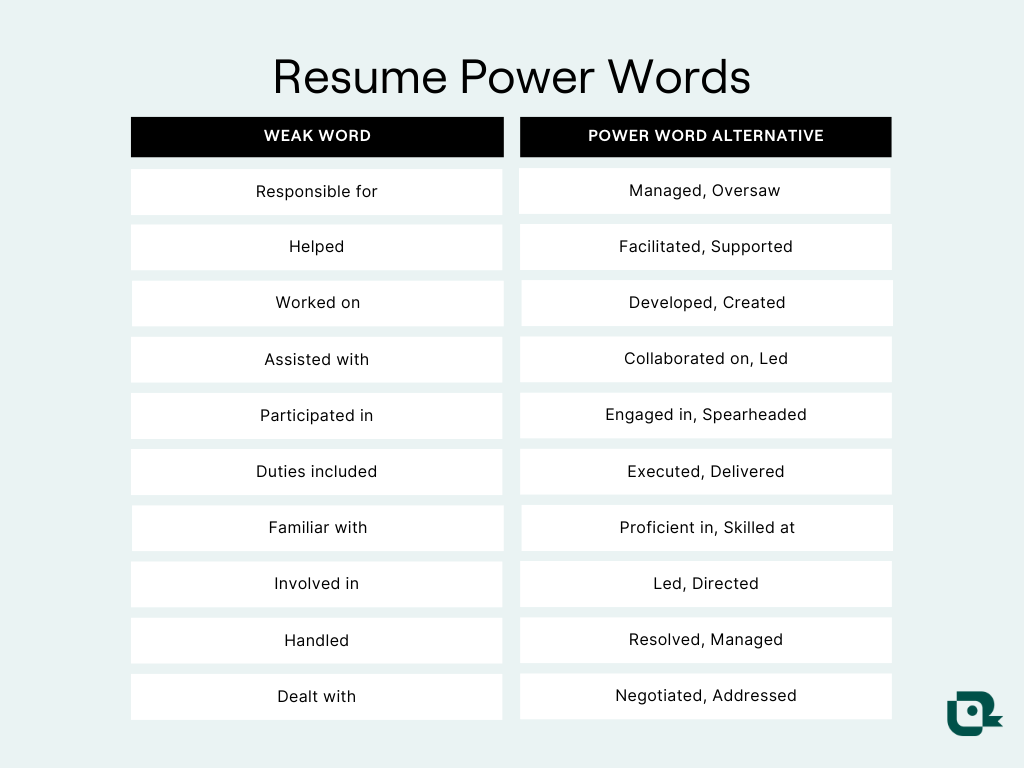
Examples of how to rewrite sentences using power words:
Weak: Responsible for managing team projects. Strong: Orchestrated cross-functional team projects, consistently delivering results 15% ahead of schedule. Weak: Helped with customer service issues. Strong: Resolved complex customer service issues, achieving a 98% satisfaction rate and reducing escalations by 30%. Weak: Worked on marketing campaigns. Strong: Developed and executed integrated marketing campaigns, driving a 25% increase in customer engagement.
Industry-specific power word examples
Tailoring your resume with industry-specific power words can draw the reader's attention to relevant achievements. These examples show how to align your language with the expectations and standards of various fields.
Technology and IT
In the world of technology and IT, precision and clarity are key. Here’s a selection of power words that can help you articulate your technical expertise and accomplishments.Power words
- Architected
Sample resume statements
- Architected scalable cloud infrastructure, reducing downtime by 99% and cutting operational costs by 30%.
- Debugged complex legacy code, improving system performance by 40% and eliminating critical security vulnerabilities.
Finance and accounting
Accuracy and attention to detail are crucial in finance and accounting. These power words will help you highlight your analytical skills and financial acumen:
Power words
- Diversified
- Strategized
- Forecasted quarterly revenue projections with 98% accuracy to aid expansion initiatives.
- Streamlined accounts payable processes, to reduce processing time by 35% and eliminate $50,000 in annual late fees.
Marketing and sales
Success in marketing and sales depends on driving engagement and converting opportunities into results. These power words will help you showcase your ability to innovate, persuade, and achieve impressive outcomes:
- Transformed
- Revolutionized
- Launched an innovative social media campaign that led to increased brand engagement by 150% and drove 10,000 new qualified leads.
- Negotiated strategic partnerships with key industry players, resulting in a 40% boost in annual revenue and expanded market share.
Healthcare and medical
In the healthcare and medical sectors, your resume usually needs to reflect both your technical skills and your dedication to patient care. These power words emphasize your expertise in delivering quality healthcare and improving patient outcomes.
- Rehabilitated
- Collaborated
- Implemented new patient care protocols, reducing average hospital stay duration by two days and improving patient satisfaction scores by 25%.
- Researched and introduced cutting-edge treatment methods, resulting in a 40% increase in positive outcomes for chronic condition management.
Education and teaching
Educators are not just teachers—they are mentors and leaders shaping the future. Use these power words to highlight your contributions to student learning, curriculum development, and educational excellence.
- Differentiated
- Developed and implemented inquiry-based science curriculum, increasing student engagement by 45% and improving standardized test scores by 30%.
- Mentored struggling students through targeted intervention programs, resulting in an 80% improvement in academic performance over one semester.
How to add power words to different resume sections using AI
Strategically incorporating power words throughout your resume can make it seem more personalized and human. Here's how Teal helps:
Professional summary
The professional summary is your chance to make a strong first impression. Use power words to concisely convey your value proposition:
Example: "Dynamic marketing strategist with a proven track record of developing innovative campaigns that drive engagement and boost ROI. Skilled in leveraging data analytics to optimize performance and deliver measurable results across diverse industries."
You can add a professional summary by using Teal’s in-built summary generator. Follow these steps:
- Import your existing resume into the Resume Builder
Import your LinkedIn profile or create a resume from scratch in minutes if you don't have one. Your summary will be more accurate if you provide more details about your career.
- Update your work experiences and add achievements
Be sure to include multiple accomplishments related to your recent roles for the best results from the Resume Summary Generator.
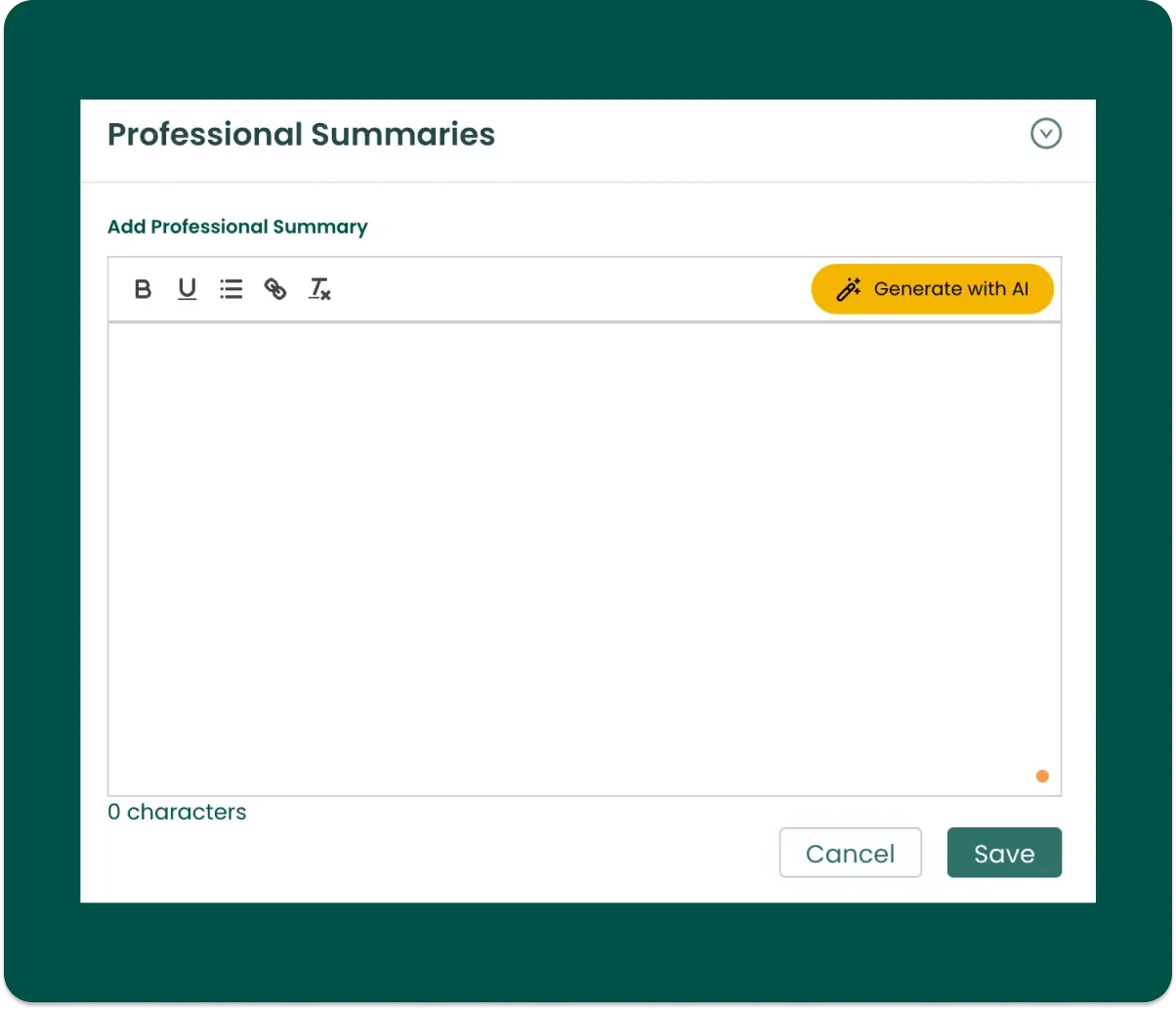
- Generate your resume summary with AI
Save the AI-generated resume summaries to your Teal Resume Builder.
- Review and regenerate your summary
By clicking "Re-generate with AI", you can generate a new professional summary based on the existing settings.
You can save multiple resume summaries so you can use different ones for different applications.
Work experience
In your work experience section, use power words to highlight your achievements and responsibilities.
Teal's AI Assistant makes this easy, automatically adding power powers to the beginning of every bullet point.
- Before: Responsible for managing team and completing projects.
- After: Spearheaded a cross-functional team of 12, delivering complex projects 20% under budget and one week ahead of schedule.
- Before: Helped with customer service and solved problems.
- After: Resolved critical customer issues, achieving a 98% satisfaction rate and reducing churn by 15%.
Skills section
Enhance your skills section by using power words that align with industry-specific competencies:
- Proficient in data visualization and predictive modeling techniques
- Adept at agile project management methodologies
- Skilled in negotiating high-stakes contracts and partnerships

Achievements and accomplishments
Use power words to make your achievements and resume stand out:
- Pioneered company-wide sustainability initiative, reducing carbon footprint by 30% and generating $2M in cost savings.
- Orchestrated merger and acquisition strategy, resulting in 50% market share growth within 18 months.
- Revolutionized customer onboarding process, slashing time-to-value by 60% and boosting retention rates by 25%.
The impact of power words on applicant tracking systems (ATS)
In today’s job market, your resume must pass through ATS before reaching human eyes. Understanding how power words interact with these systems can give you a crucial edge in landing an interview.
How ATS process power words
Applicant tracking systems (ATS) play a crucial role in the initial screening of resumes. Here’s how they interact with power words:
- Keyword matching: ATS scan resumes for specific keywords related to the job description.
- Relevance scoring: Resumes are ranked based on the presence and frequency of relevant terms.
- Contextual analysis: Advanced ATS can understand the context in which words are used, not just their presence.
- Skill identification: Power words often signal specific skills or experiences that match job requirements.
Strategies for ATS-friendly power word usage
To ensure your resume is both ATS-friendly and impactful:
- Incorporate relevant keywords: Use keywords from the job description naturally throughout your resume.
- Balance power words and keywords: Mix industry-standard terms with relevant power words.
- Avoid overstuffing: Don’t overuse keywords or power words to the point of reducing readability.
- Use standard formatting: Stick to simple, ATS-compatible formatting to ensure all keywords and power words are recognized.
Measuring the effectiveness of your power words
Crafting the perfect resume requires continuous refinement. A/B testing and gathering feedback are essential for measuring the impact of your power words and ensuring your resume resonates with employers.
A/B testing your resume
A/B testing your resume can help determine the effectiveness of different power word usage:
- Create variants: Develop two versions of your resume, each using different sets of power words.
- Submit both versions: Apply to similar jobs with both resume versions.
- Track responses: Monitor the response rate from employers for each version.
- Analyze results: Determine which version received more positive feedback or job interview invitations.
Gathering feedback
Professional feedback is crucial for refining your resume:
- Ask for reviews: Request input from career coaches, mentors, or peers.
- Use online services: Utilize professional resume review services for expert advice.
- Interpret feedback: Analyze the feedback received to understand how your power word usage can be improved.
Power up your career with resume power words
To create a distinct resume, use words that pack a punch and highlight your achievements with precision. Power words tailored to the job and industry can elevate your resume’s impact. But remember, balance is crucial—combine these words with metrics and case studies to avoid sounding superficial.
Start by refining your resume and adding or improving power words where needed. Teal’s AI-powered Resume Builder can streamline this process, helping you craft a resume that grabs attention.
Frequently Asked Questions
How many power words should you include in your resume.
Balance is crucial when incorporating power words into your resume. Aim for one to two power words per bullet point to maintain a strong yet natural tone. This ensures your resume is impactful without appearing exaggerated.
Can using too many power words hurt your chances of getting hired?
Yes, overusing power words can hurt your chances by making your resume seem insincere or cliché. It’s important to use power words genuinely to reflect your true experiences and achievements. Mixing power words with straightforward language helps maintain a natural flow.
Are there any power words you should avoid in your resume?
Avoid overused or cliché power words like "committed dynamic," "synergy," "hardworking," and "go-getter." These terms can make your resume seem generic and unimpressive. Instead, choose more industry-specific and impactful alternatives that accurately describe your skills and achievements.
How can you use power words if you're just starting your career?
If you're starting your career, focus on highlighting transferable skills gained from internships, volunteer work, or academic projects. Use power words to emphasize your enthusiasm and potential for growth. For example, instead of "participated in a marketing project," say "spearheaded a marketing project that increased social media engagement by 20%."

Related Articles
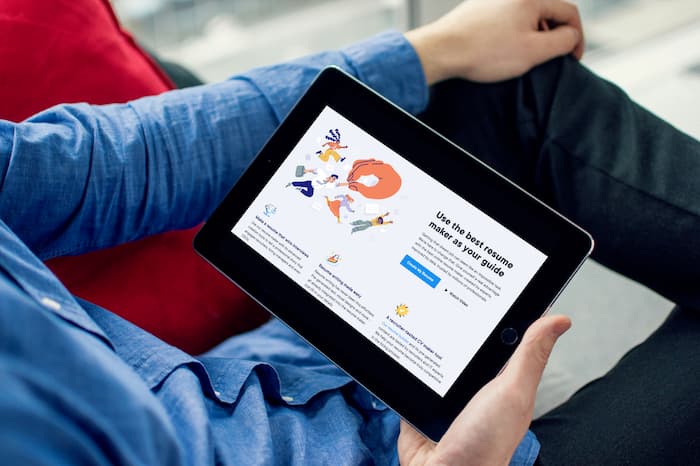
Resume.io Reviews: User Feedback & Ratings

Resume Now Reviews: Ratings & Customer Feedback

How Oktavianus 11x'd First-Round Interviews in One Week Using Teal

We help you find the career dream.

How to Insert Lines in Word for Resume: A Step-by-Step Guide
- Career Advice

- Posted On: 2024-08-18
- Posted By: Shacara
Why Use Lines in a Resume?
- Organize Content: Lines can help divide different sections of your resume, such as education, work experience, skills, and references. This makes it easier for hiring managers to scan through your resume quickly.
- Improve Readability: A well-placed line can guide the reader’s eye, making your resume more navigable and aesthetically pleasing.
- Highlight Key Information: You can use lines to emphasize section headers or specific achievements, drawing attention to the most important parts of your resume.
- Professional Appearance: Lines contribute to a clean and structured layout, which can give your resume a more professional appearance.
Step-by-Step Guide to Inserting Lines in Word for Resume
Method 1: using the horizontal line tool.
- Go to the "Home" tab in the ribbon.
- Click on the "Borders" dropdown in the Paragraph group.
- Select "Horizontal Line" from the dropdown menu.
- Right-click on the line and choose "Format Horizontal Line…" from the context menu.
- You can adjust the width, height, color, and alignment of the line to match your resume’s design.
Method 2: Using the Borders Tool
- In the Paragraph group, click on the "Borders" dropdown.
- Select "Bottom Border" to insert a line directly beneath the text.
- To customize the border, click on "Borders and Shading…" at the bottom of the Borders dropdown.
- In the dialog box that appears, you can adjust the style, color, and width of the line.
- You can also apply the line to the top, bottom, left, or right of the text, depending on your needs.
Method 3: Using the Underline Feature
- Go to the "Home" tab.
- Click on the "Underline" button (represented by a "U" with a line beneath it) in the Font group.
- Alternatively, you can use the shortcut Ctrl + U to quickly apply an underline.
- To change the style or color of the underline, click the small arrow next to the Underline button.
- Select "More Underlines…" to access additional options, including different line styles and colors.
Method 4: Inserting Lines with Shapes
- Go to the "Insert" tab in the ribbon.
- Click on "Shapes" in the Illustrations group.
- Select the "Line" shape from the Lines category.
- Click and drag to draw the line where you want it on your resume.
- Hold down the Shift key while dragging to keep the line straight.
- Once the line is drawn, you can customize its appearance by right-clicking on it and selecting "Format Shape."
- Here, you can adjust the color, weight, and style of the line, as well as add effects like shadows or glow if desired.
Method 5: Creating a Custom Table Layout
- Go to the "Insert" tab.
- Click on "Table" and choose the number of rows and columns you need.
- Click on the table to select it.
- Go to the "Table Design" tab that appears.
- In the Borders group, click on "Borders" and select "No Border" to remove all borders.
- You can now add borders selectively to certain cells to create lines where needed.
- For example, you might add a bottom border to a row to create a line beneath a section header.
Best Practices for Using Lines in Your Resume
- Use Lines Sparingly: Too many lines can make your resume look busy and cluttered. Stick to using lines only where they help improve readability or emphasize important sections.
- Keep It Consistent: Consistency is key to a professional resume. Use the same line style, weight, and color throughout your resume to maintain a cohesive look.
- Balance White Space: Lines can help structure your resume, but it’s important to balance them with white space. This ensures that your resume remains easy to read and visually appealing.
- Align with Your Resume’s Design: The lines you use should complement the overall design of your resume. For example, if you’re using a minimalist template, opt for simple, thin lines. If your resume has a more modern design, you might experiment with bolder lines or unique styles.
Using mycvcreator.com to Design Your Resume
- Customizable Templates: mycvcreator.com offers a range of resume templates that incorporate lines and other design elements, allowing you to create a professional-looking resume without the hassle.
- Easy-to-Use Interface: The platform provides a user-friendly interface where you can drag and drop elements, insert lines, and customize your resume layout to suit your needs.
- Instant Formatting: With mycvcreator.com , you don’t need to worry about formatting issues. The platform automatically adjusts margins, spacing, and alignment to ensure your resume looks polished and professional.
- Real-Time Editing: You can make changes to your resume in real-time, adding or removing lines as needed and previewing how your resume will look once completed.
Get ahead of the competition
Make your job applications stand-out from other candidates.
Create your Professional Resume and Cover letter With AI assistance.
Contact Info
- Mon to Sun : 24/7 NG +234 813 553 1603
- Do You Have a Question? [email protected]
Quick Links
- Download Apps
- Order a Resume
- Cover Letter
- Word Template
Our Company
- Privacy Policy
- Terms & Conditions
- Affiliate Program
- Sponsorship Program
Copyright 2024 My Cv Creator . All rights reserved

IMAGES
COMMENTS
The Online Resume Builder so Easy to Use, the Resumes Write Themselves. Try Now! Use a Free Resume Builder to Build Your Perfect Resume. Start Today!
America's #1 Resume Maker. Make a Word Resume. Free!
Make a Resume in Microsoft Word in 7 Easy Steps. First, let's make sure you can navigate the Microsoft Word ribbon! The ribbon is the toolbar found at the top of the screen. It should look something like this: The main parts of the ribbon you should familiarize yourself with on the Home tab are Font, Paragraph, and Styles.
Download free resume templates. Land your dream job with free, customizable resume templates. Showcase your potential to recruiters and stand out from other candidates with a professional template. Whether you're applying to corporate positions or creative roles, go with a sleek design or show your creativity with bold colors.
First, click the "More" arrow on the right-hand side of the different built-in styles. You'll see a menu with three different options. Go ahead and click "Create a Style." The "Create New Style from Formatting" window will appear. The only thing you can do here is to name the style, so click "Modify."
Step #1: Pick a Word Resume Template. The first step in making a resume in Word is accessing its free resume templates. How you access the templates may change depending on the Microsoft Word version you're using, but what you ultimately need to do is the following: Open Word. Select one of the Resume templates Word suggests, or simply search ...
Just pick the template you want, and our software will format everything for you. 1. Pick a template for your Word document resume. Creating a resume in Word starts with choosing the right template. Open Word and search for "resume" using the search bar in the top right-hand corner. This will bring up a range of resume templates for Word.
In this step-by-step tutorial, learn how to create a professional and eye-catching resume in Microsoft Word. In this video, I show you how to make a resume i...
1 Open Microsoft Word. 2 Go to the search bar and type "resume.". Pick one of the pre-formatted resume templates that pop up. 3 Edit the filler text on the resume template with your professional information. 4 Save your document as a PDF and send it via email or submit it to an online job application form.
1. Start with a header. This element can list your contact information, including your first and last name, email address and phone number. Depending on the template you select, this information is often bold and centered at the top of your resume. Simply add your information to the template by clicking each line and typing the required contact ...
Whether you're online or offline go to FILE > New and search for "Resume.". Preview and click the one you want to open. You can start typing right away or cut and paste text into the document. After pasting old text, it might look funny, or not formatted correctly. Select Ctrl to see Paste Options and choose one like Keep Text Only.
Use a built-in Word resume template. The quickest and easiest way to make a resume in Word is using one of Microsoft's templates.You can look for one directly in Word and choose from a large ...
To create a resume using a Microsoft Word resume template, follow these steps: Choose your template in Word. To create your resume from scratch, click "File" in your Microsoft Word menu (you can also hit Alt+F on a PC or Command+F on a Mac).Click "More templates" to see a selection of Word resume template layouts.
Here's how to select a resume template in Microsoft Word: 1. Open Microsoft Word and click on "File" in the top left corner of the screen. 2. Click on "New" from the menu options. 3. In the search bar at the top of the screen, type in "resume". 4.
Add a Resume Objective/Summary. Double space from the last line in your resume header. Write "Objective" or "Summary" depending on which one you're using. As it's a section title, make it a little larger than the rest of the text (14-16 pt). Also, depending on the font you're using, make it bold.
Start by selecting "New" from the File menu. This displays the New Document task pane. You should then select "My Computer" from the Templates section on the left side of the task pane. Click on the "Other Documents" tab, and then select "Resume Wizard.".
Windows macOS Web. Go to File > New. In the search box, type Resume or Cover Letter. Double-click the template you want to use. Replace the placeholder text with your own information. Making a resume like this while you're online is quick and easy. This template comes with a cover letter, so you'll have everything in one document.
Step 2: Choose a Word resume template. When you open Word, you'll find suggested resume templates. The first suggestions are just a few of the available options in Word. If you search for "Word resume templates," you'll find many more available to use.
Related: Resume samples and templates to inspire your next application. 2. Include your name and contact information. Your resume should begin with your name and contact information, including your professional email address and phone number. You have a choice about whether or not to include your mailing address.
Starting with Microsoft Word is a smart move. According to Amanda Augustine, a career expert and resume writer for TopResume, files that end in ".docx" are the safest to submit to an applicant tracking system (ATS), the software that companies use to organize and analyze applications and identify the most promising candidates for a given role (often before a human is ever involved).
One of the most convenient ways to make a resume is to download a free resume template. To get started, download the template below and fill in each section as you follow our simple writing steps. Download This Free Template. 2. Enter your contact information.
Open Word, and on the left side of the screen choose "New" to create a new document. For advice on using a Google Docs template, click here. Next, use the search bar to search for resume templates. Word will supply you with dozens of online templates to choose from. Scroll through the results and find one that is appealing to you, but also ...
Windows macOS Web. Go to File > New. In the search box, type Resume or Cover Letter. Double-click the template you want to use. Replace the placeholder text with your own information. Making a resume like this while you're online is quick and easy. This template comes with a cover letter, so you'll have everything in one document.
If you can't see the templates, change your display language to English: Go to "Manage Your Google Account" → "Personal Info" → "General Preferences for the Web/Language.". Click "Edit" and select English. Choose a Google Docs resume template to build a simple resume.
Learn how to easily create or customize a resume or CV with the help of Microsoft Word. Especially powerful is the Resume Assistant that is part of Microsoft...
Professional introduction: The About Me section is your chance to make a strong first impression, offering employers a sense of who you are as a professional.; Highlight key qualifications: This section summarizes your most relevant qualifications, including years of experience and areas of expertise.; Link experience to goals: Your About Me section connects your resume work history with your ...
195 resume power words to supercharge your application. To make your resume stand out, use words that showcase your achievements. Here's a list of resume power words designed to help your application leave a lasting impression on hiring managers. Resume action verbs. Strong action verbs communicate your exact responsibility in a job role.
Use Lines Sparingly: Too many lines can make your resume look busy and cluttered. Stick to using lines only where they help improve readability or emphasize important sections. Keep It Consistent: Consistency is key to a professional resume. Use the same line style, weight, and color throughout your resume to maintain a cohesive look. ...
Using the same old word repeatedly on your resume can make it feel as exciting as watching paint dry. And you want the opposite, especially since there is an average of 250 resumes on your recruiter's desk. You need a resume that stands out! But fear not! Synonyms are here to save the day. By swapping out tired words like "created" for fresh ...
Successfully completing your Microsoft Word training and becoming certified demonstrates mastery of one of the most desired workplace software skills by employers of any industry. Adding this credential to your resume sets your professional profile apart from the casual Word user. It validates your skills and proficiency as well as demonstrates your initiative and dedication.